



| year | president | . . | treasurer | . . | comptroller |
| 1912 | William G. McAdoo | Hamilton S. Corwin | |||
| 1914, 1915, 1917, 1918 | Wilbur C. Fisk | Fletcher. H. Sillick | |||
| 1919 (United States Railroad Administration - WW1) | K. B. Conger | ||||
| 1924, 1925, 1926, 1927, 1928, 1929, 1930 | Oren Root | ||||
| 1931, 1932, 1933, 1935 | C. D. Emmons | ||||
| 1933, 1934, 1936, 1937, 1939 | C. S. Klumpp | ||||
| 1946 | Walter Brown | ||||
| 1947 | Robert Carleton | ||||
| 1950 | William Reid | ||||
| 1951 | J. J. Fritsch | ||||
| 1956 | Stichman | ||||
| August 1, 1956 | W. F. Franklin | F. U. Masterson |
| Hudson & Manhattan Railroad: 1907 - 1962 | ||
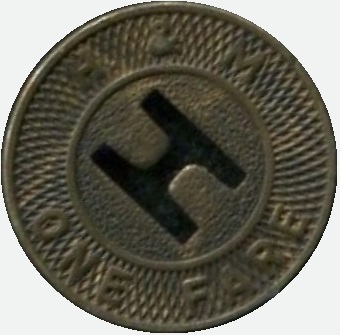 |
reverse same as obverse | June 26, 1946 through November 26, 1946 - 9 cents (11 tokens for $1.00) (all passengers) 16mm, copper (cadmium?) plated, H cut out Atwood-Coffee NY630AJ |
|
|
||
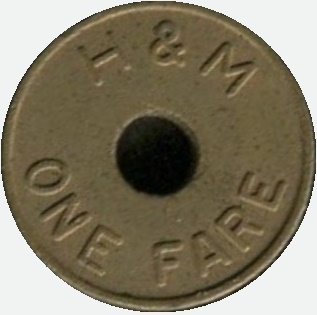 |
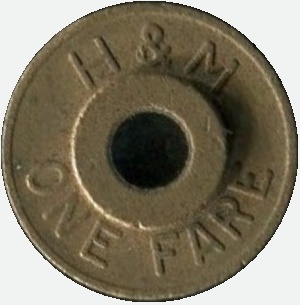 |
November 26, 1946 through March 19, 1950 - 10 cents (ticketed passengers only) 18mm, bronze, hub token - 9mm hub, 5mm hole Atwood-Coffee NY630AL |
|
|
||
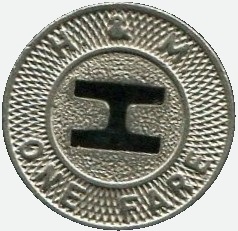 |
reverse same as obverse | March 19, 1950 to December 13, 1951 - 15 cents (unticketed passengers) 16mm, copper nickel, H cut out Atwood-Coffee NY630AH |
| These two tokens (the one above ▲ and the one below ▼) were used concurrently. | ||
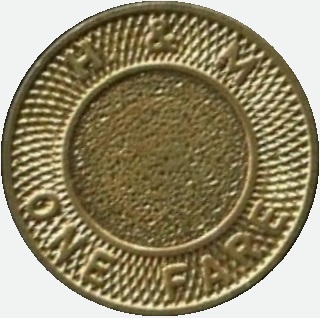 |
reverse same as obverse | March 19, 1950 to December 13, 1951 - 15 cents (ticketed passengers only) 16mm, brass, solid Atwood-Coffee NY630AI |
|
|
||
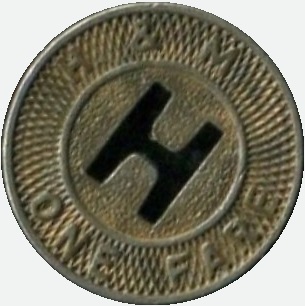 |
reverse same as obverse | December 13, 1951 - 20 cents (all passengers) 16mm, brass plated, H cut out Atwood-Coffee NY630AK |
Daily Tickets - 2 cents (Sixth Avenue Line) |
||||
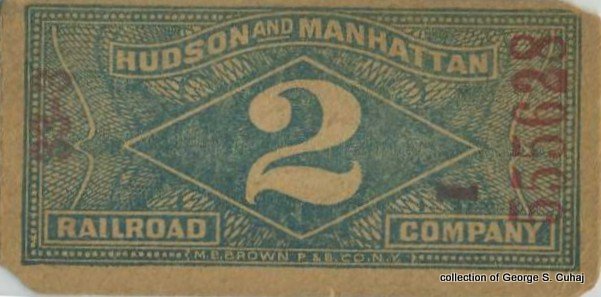 |
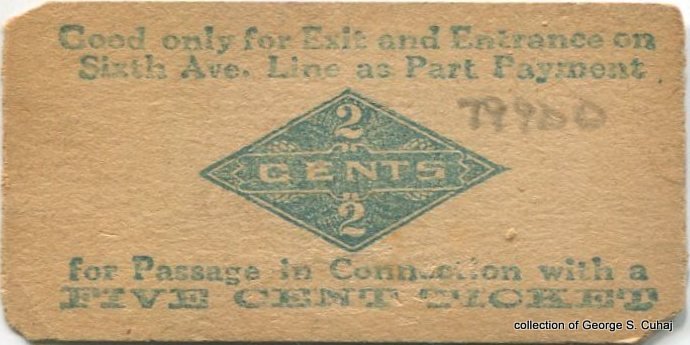 |
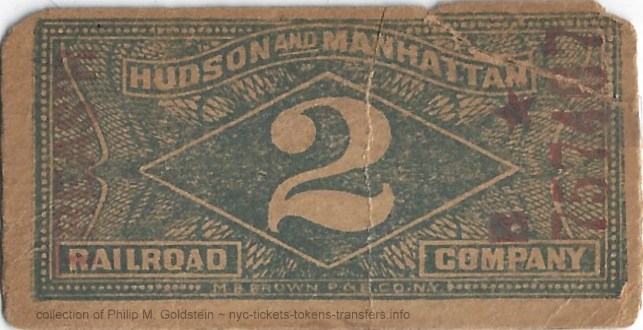 |
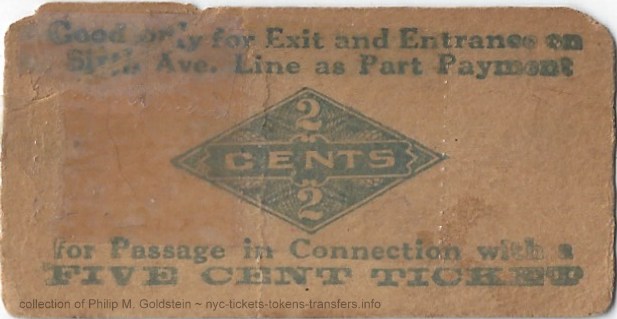 |
|
| 2 Cent - 1908-1921 33rd Street, Manhattan, NY M. B. Brown P & B Co 2" x 1" |
2 Cent - 1908-1921 Treasurers Account M. B. Brown P & B Co 2" x 1" |
|||
| . . |
||||
| Daily Tickets - 5 cents | ||||
 |
 |
|||
| 5 cent - 1908-1921 (attached pair) Exchange Place, NJ American Bank Note Co 2" x 1" |
||||
| . . |
||||
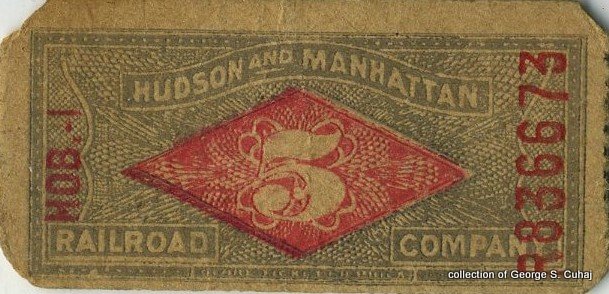 |
 |
..... | 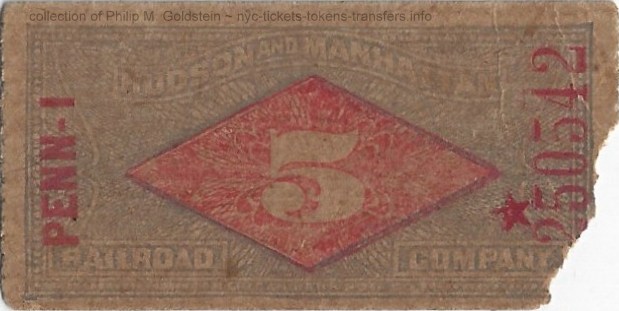 |
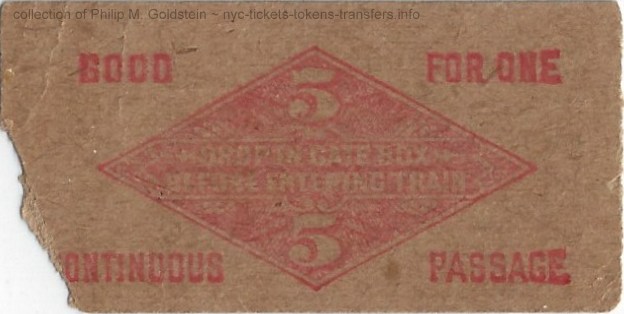 |
| 5 cent - 1908-1921 Hoboken, NJ Globe Ticket 2" x 1" |
5 cent - 1908-1921 Penn Station, Jersey City, NJ American Bank Note Co. 2" x 1" |
|||
| . . |
||||
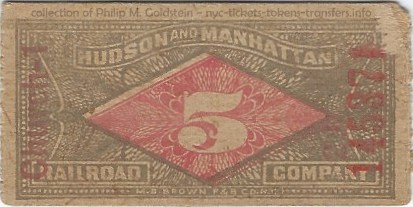 |
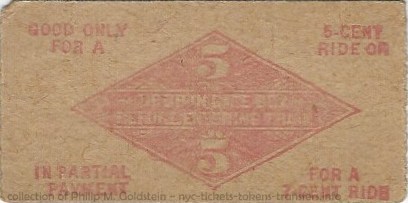 |
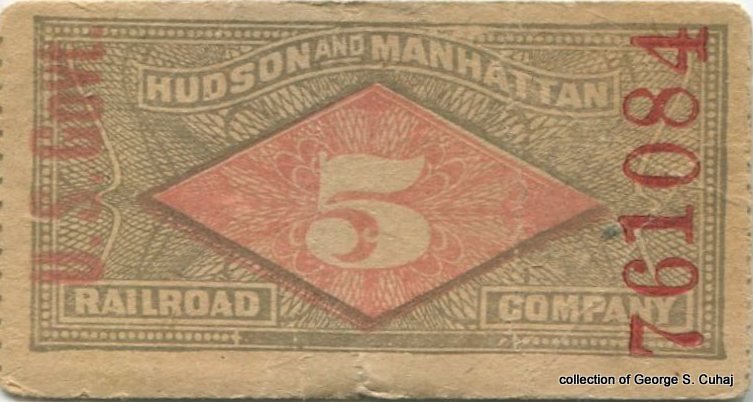 |
 |
|
| 5 cent - 1908-1921 Church Street - 1 M. B. Brown P & B Co. 2" x 1" |
5 cent - 1908-1921 US Government (no printer marked) 2" x 1" |
|||
| . . |
||||
| Block Ticket - 8 cents | ||||
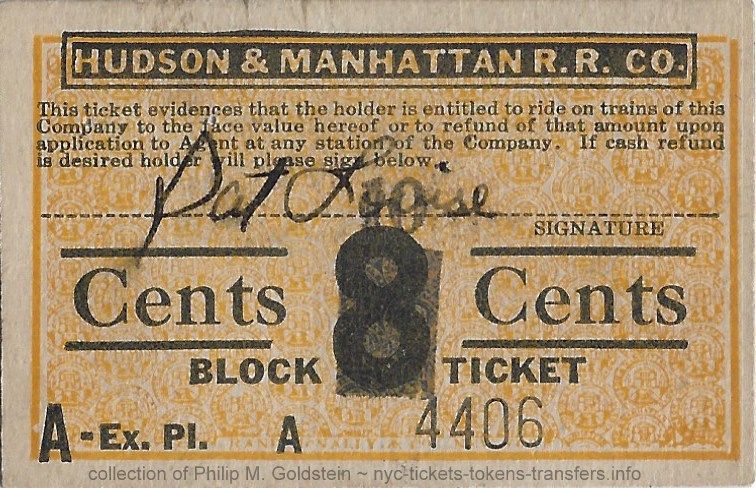 |
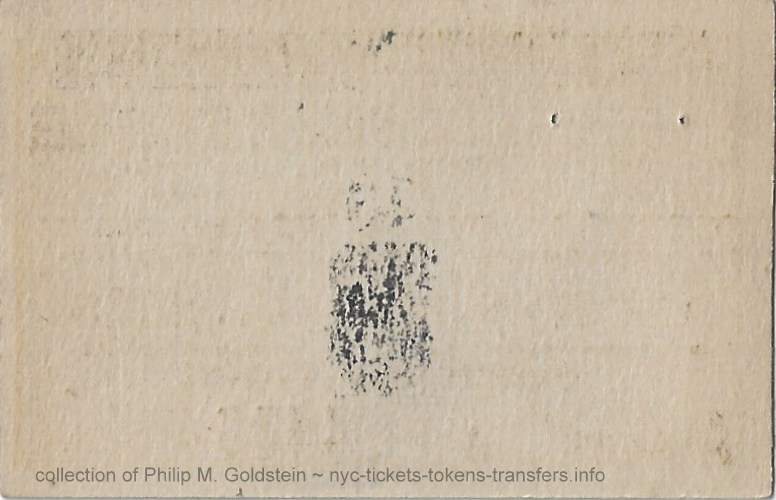 |
|||
| 8 cents (redacted) - ca. 1938? Exchange Place - A Rand McNally 2½" x 1⅝" This ticket evidences that the holder is entitled to ride on trains of this Company to the face value hereof or to refund of that amount upon application to Agent at any stationof the Company. If cash refund is desired holder wil sign below. It appears the numeral 8 was blocked out upon signature refund of the 8 cents. |
||||
| 15 Day Excursion | ||||
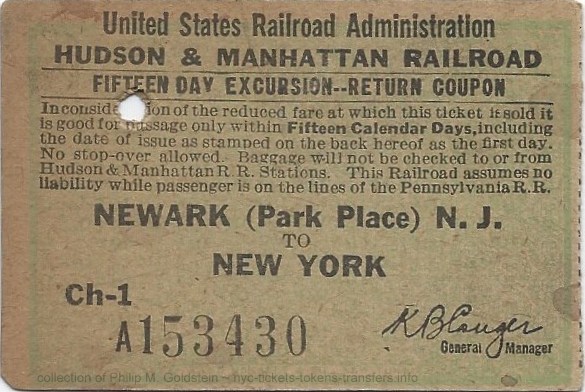 |
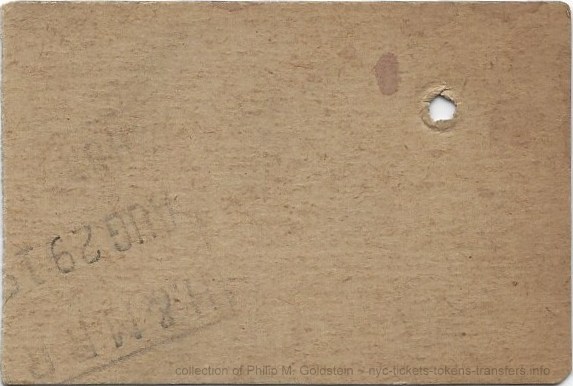 |
 |
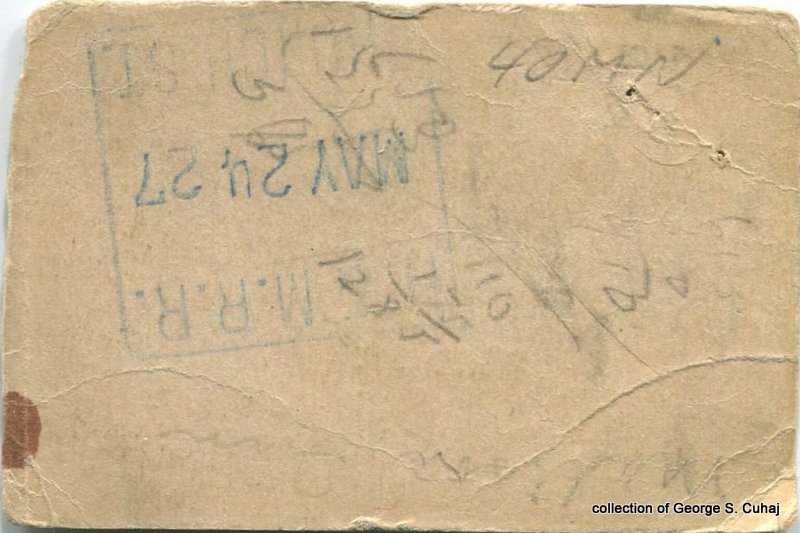 |
|
| Church Street Station, Manhattan, NY - August 29, ???? (1917-1920) United States Railroad Administration - during World War I K. B. Conger, General Manager Rand McNally 2 3/4" x 1 7/8" |
Church Street Station, Manhattan, NY - May 24, 1927 Oren Root, President Rand McNally 2 3/4" x 1 7/8" |
|||
| . | ||||
 |
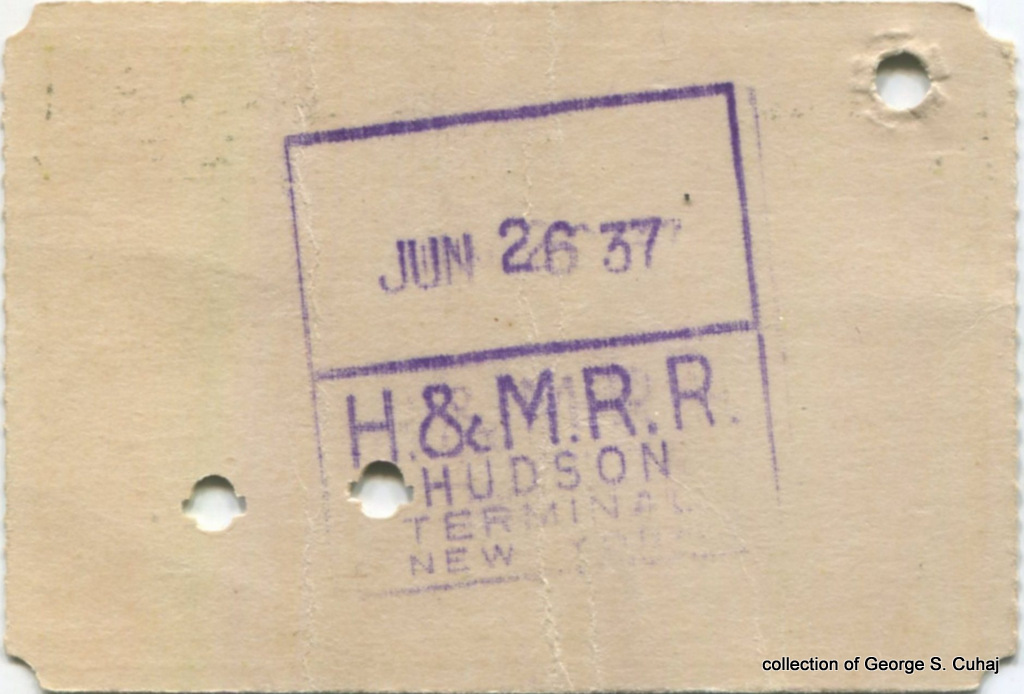 |
|||
| Hudson Terminal - June 26, 1937 Carl S. Klumpp, President & General Manager Rand McNally |
||||
| . | ||||
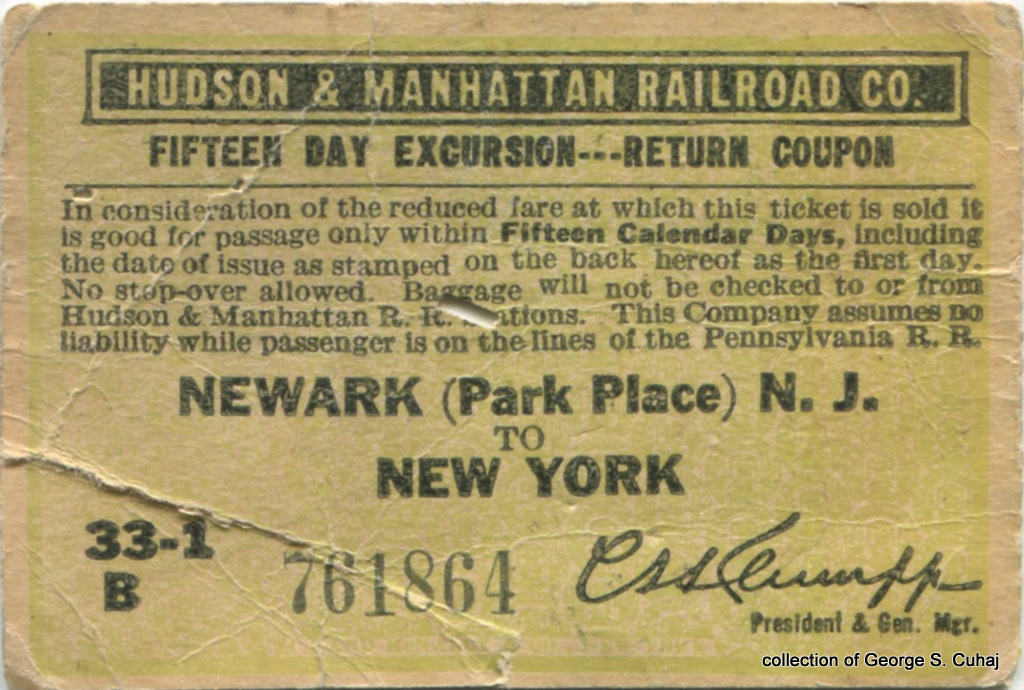 |
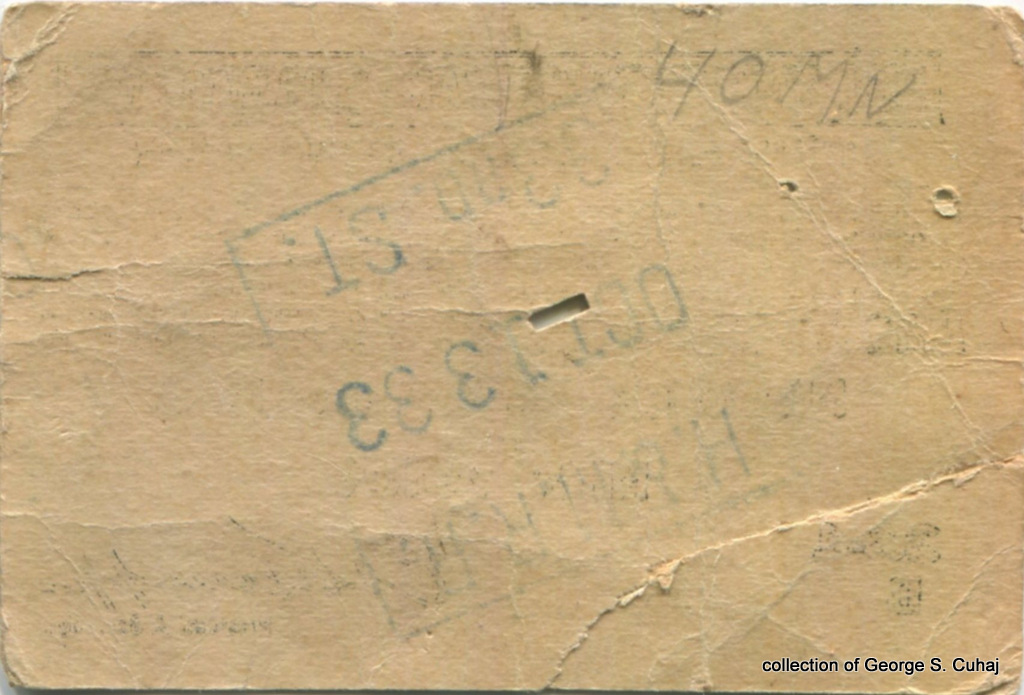 |
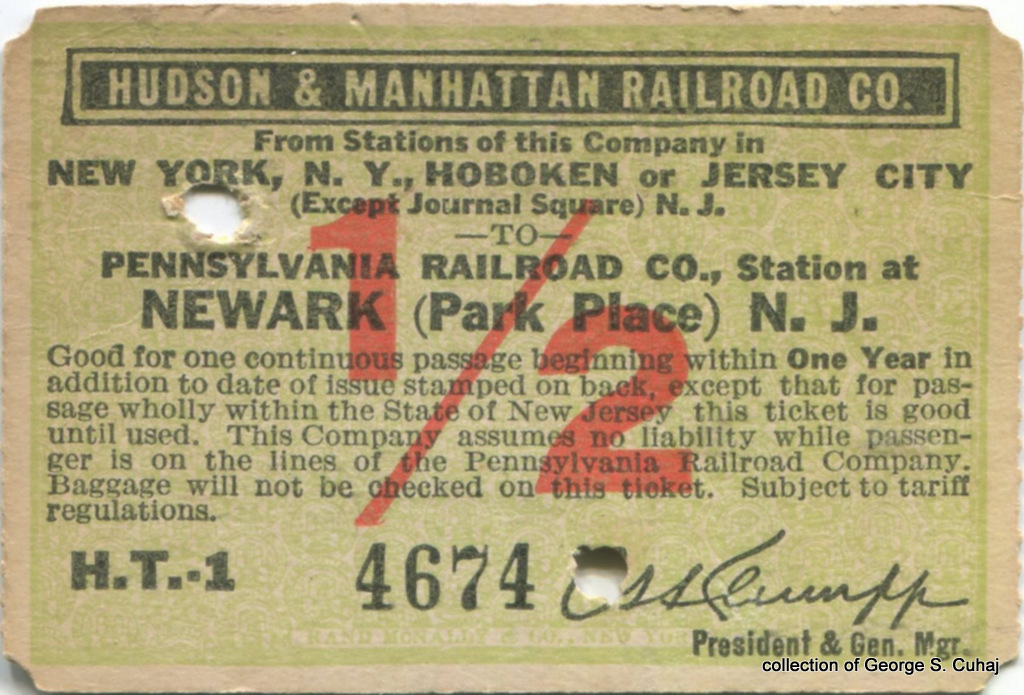 |
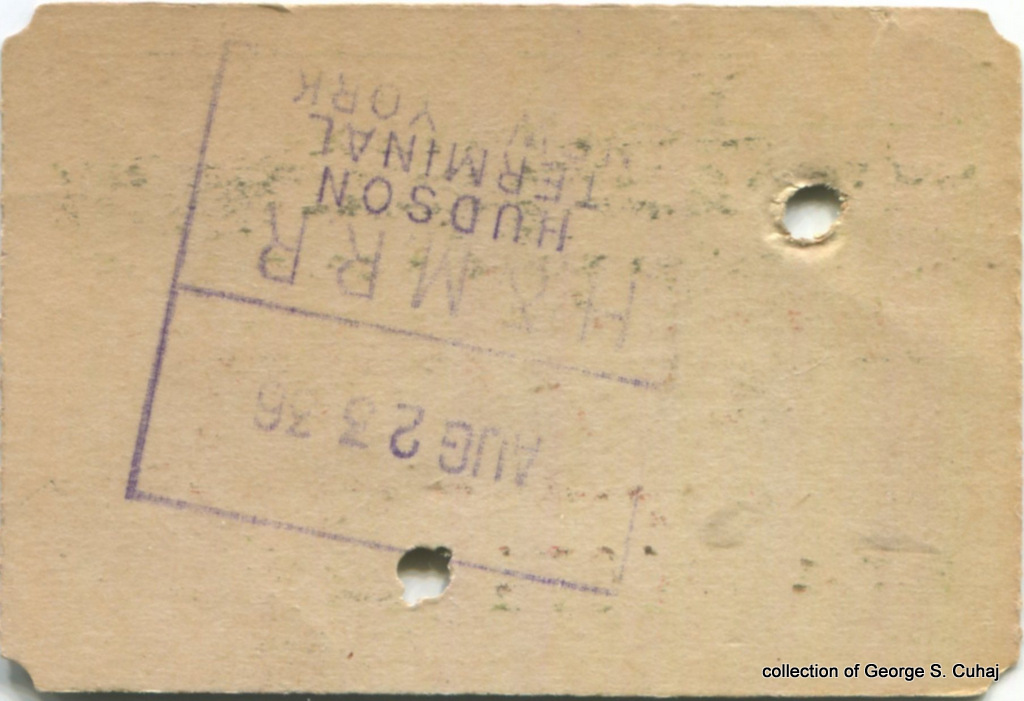 |
|
| 33rd Street - October 13, 1933 Carl S. Klumpp, President & General Manager Rand McNally |
Hudson Terminal - August 23, 1936 Half Fare Carl S. Klumpp, President & General Manager Rand McNally |
|||
| . | ||||
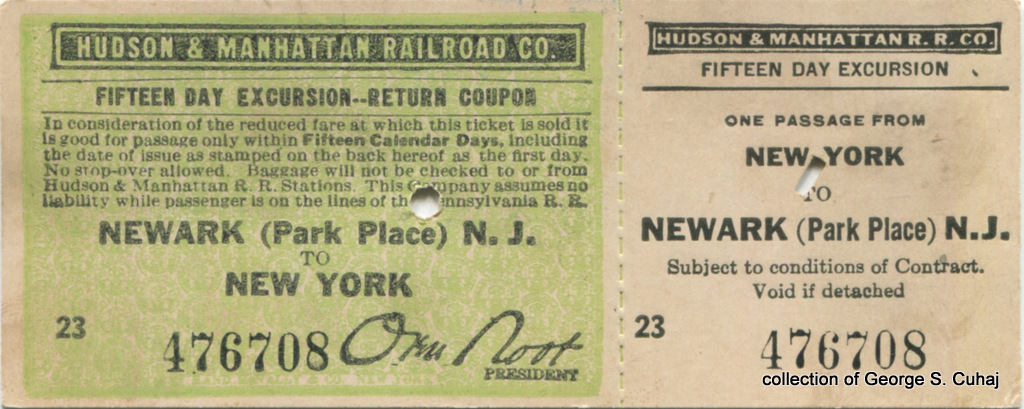 |
 |
|||
| 23rd Street - November 15, 1924 Oren Root, President Rand McNally |
||||
| . | ||||
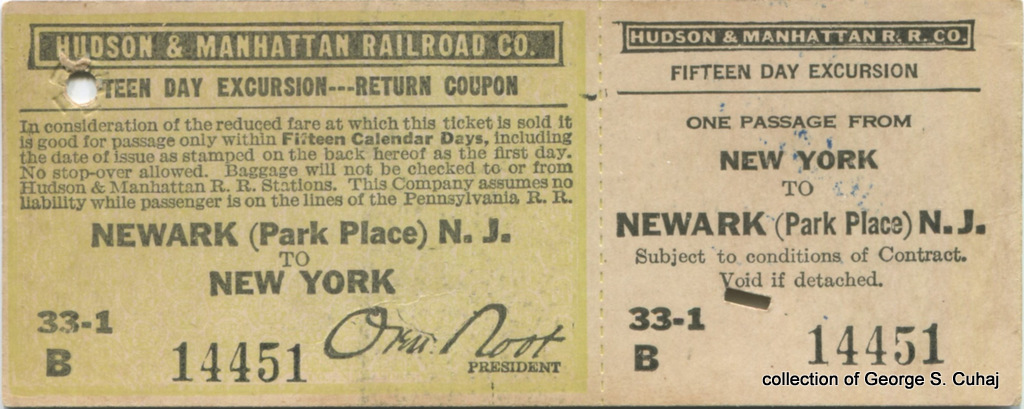 |
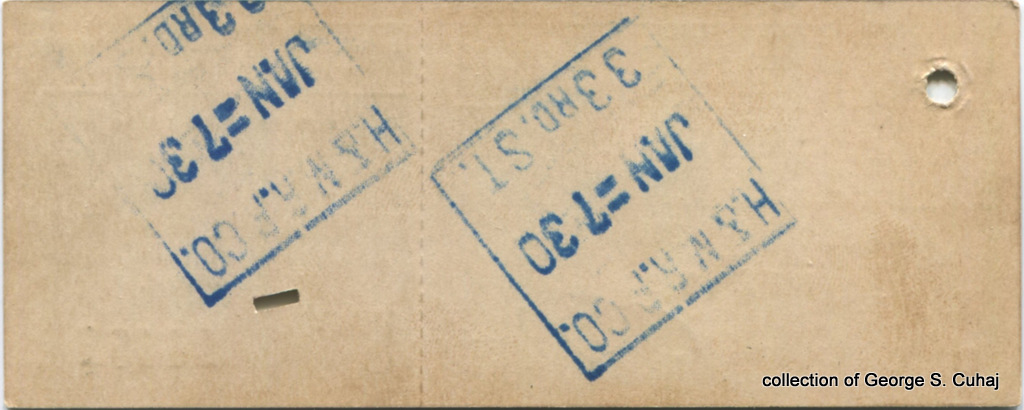 |
|||
| 33rd Street - January 7, 1930 Oren Root, President Rand McNally |
||||
| . | ||||
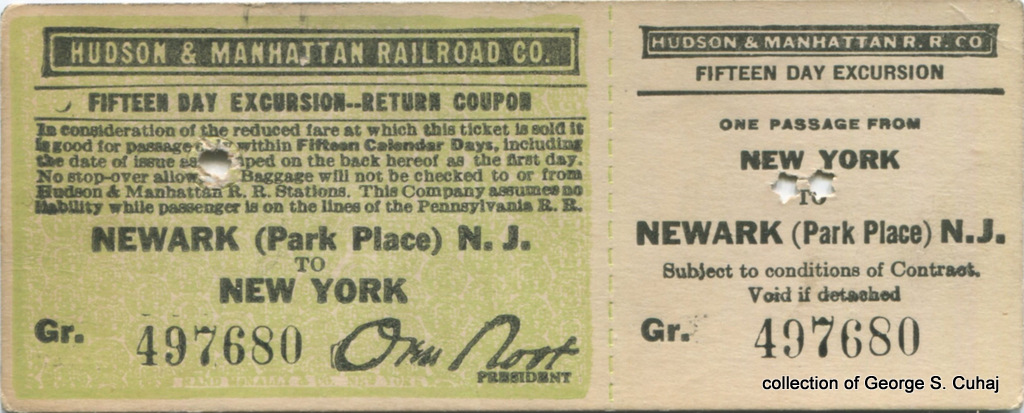 |
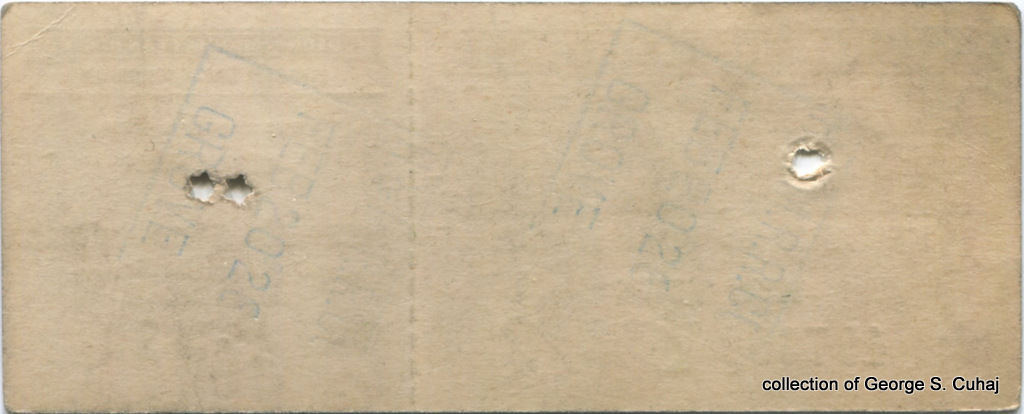 |
|||
| Grove Street Station, NJ - February 20, 1928 Oren Root, President Rand McNally |
||||
| . | ||||
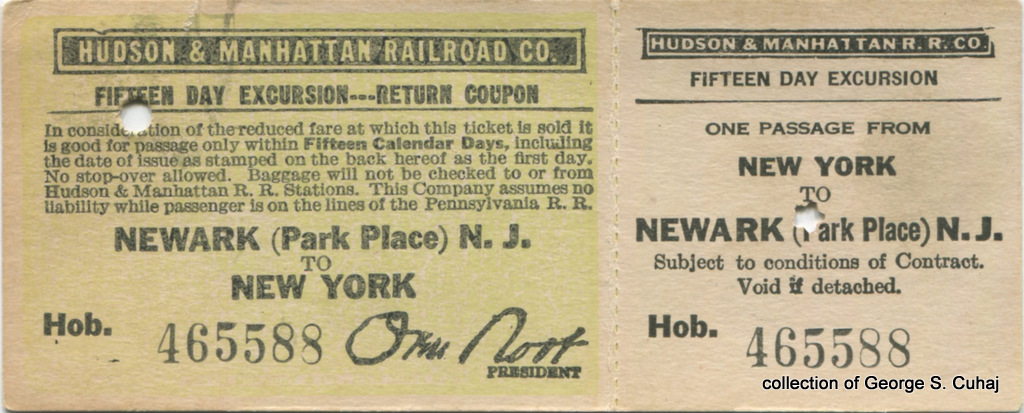 |
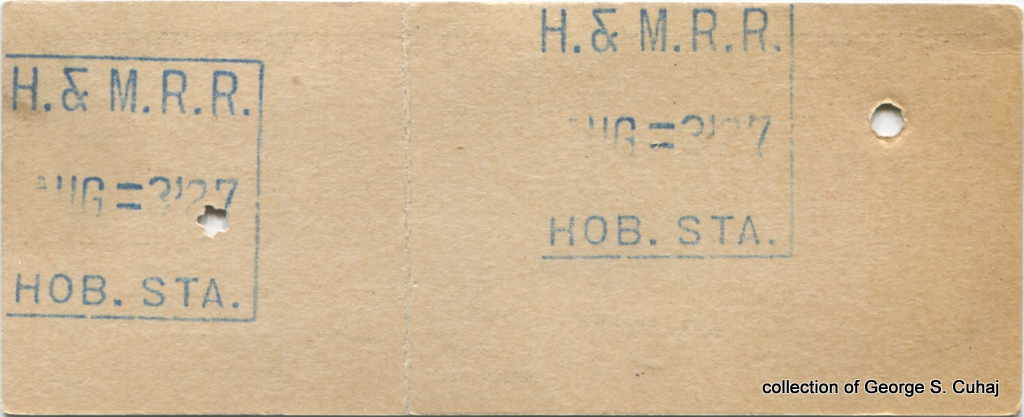 |
|||
| Hoboken Station, NJ - August 3, 1927 Oren Root, President Rand McNally |
||||
| . | ||||
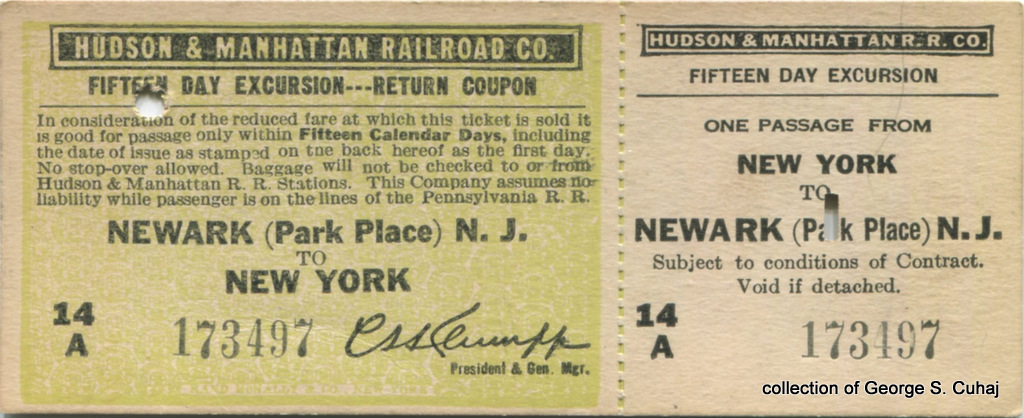 |
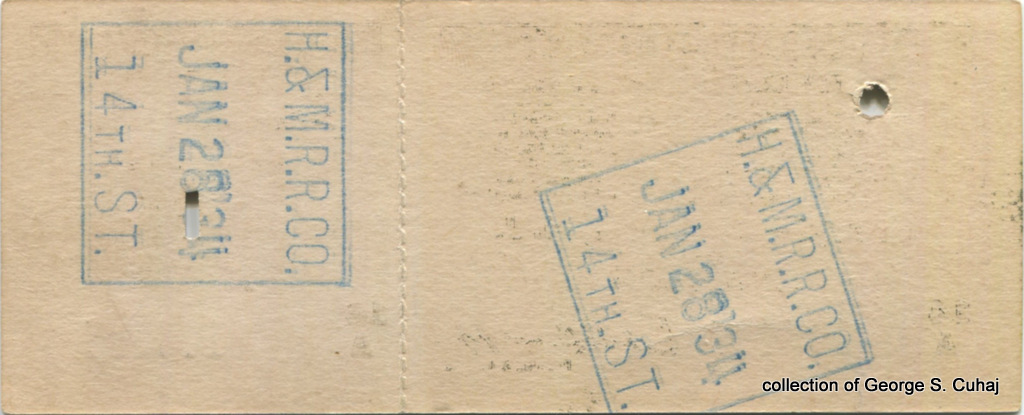 |
|||
| 14th Street, Manhattan, NY - January 28, 1934 Carl S. Klumpp, President & General Manager Rand McNally |
||||
| . | ||||
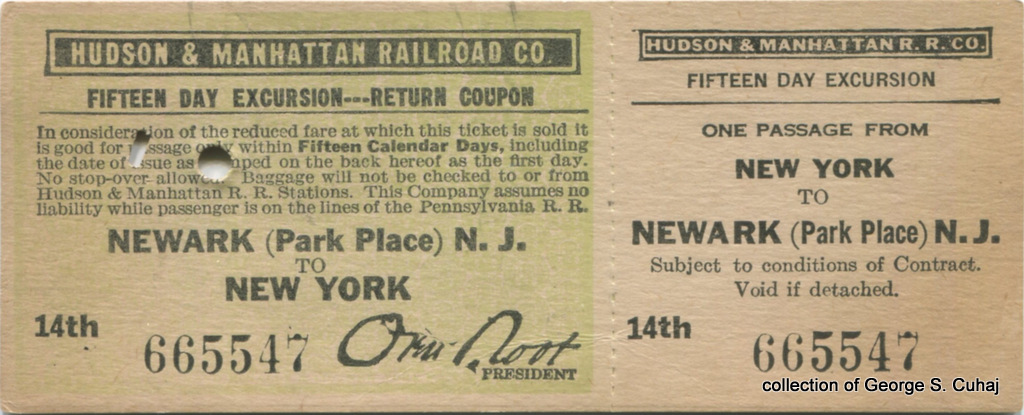 |
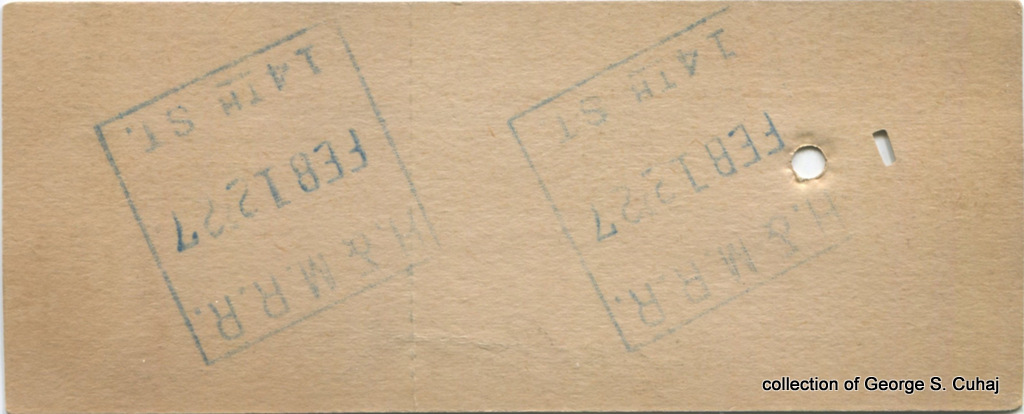 |
|||
| 14th Street, Manhattan, NY - February 12, 1927 Oren Root, President Rand McNally |
||||
| . | ||||
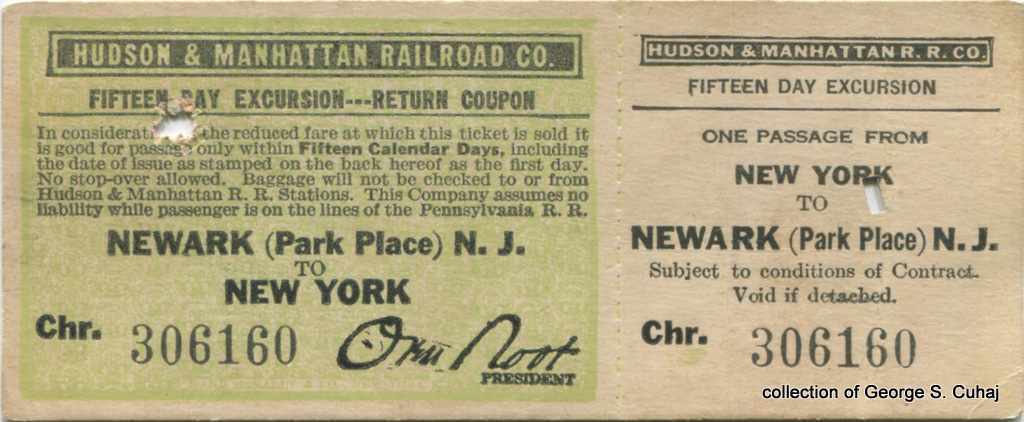 |
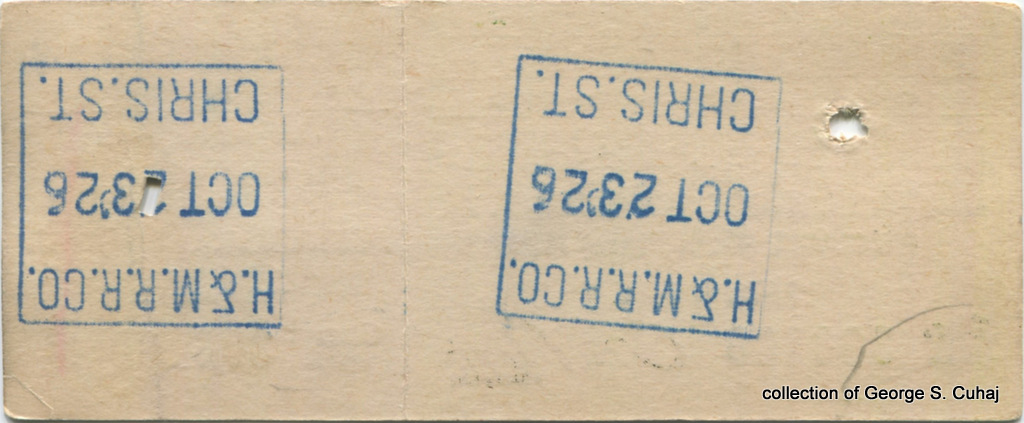 |
|||
| Christopher Street, Manhattan, NY - October 23, 1926 Oren Root, President Rand McNally |
||||
| . | ||||
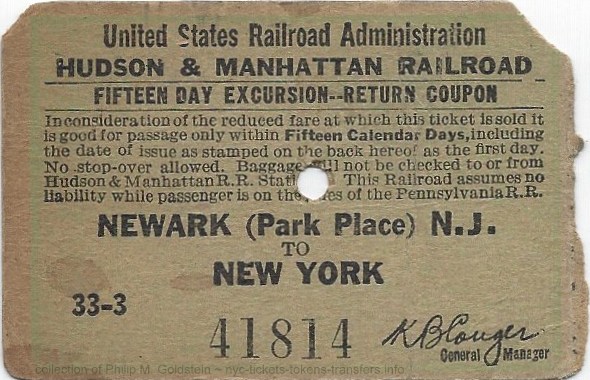 |
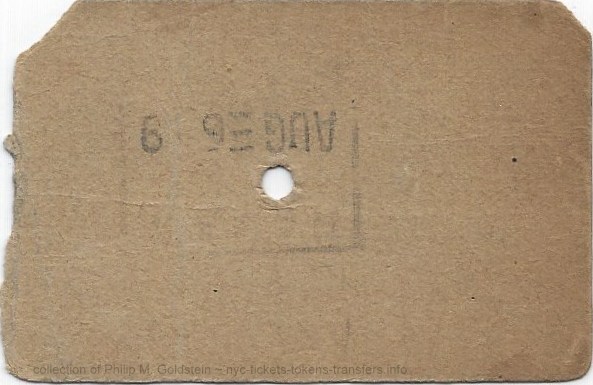 |
intentionally left blank | intentionally left blank | |
| 33rd Street Station, Manhattan, NY - August 6, 1919 United States Railroad Administration - during World War I K. B. Conger, General Manager Rand McNally 2 3/4" x 1 7/8" |
||||
| . | ||||
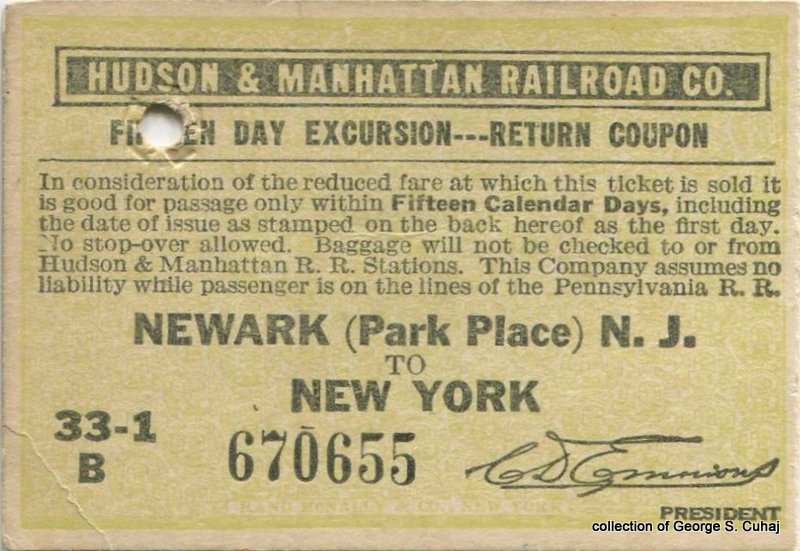 |
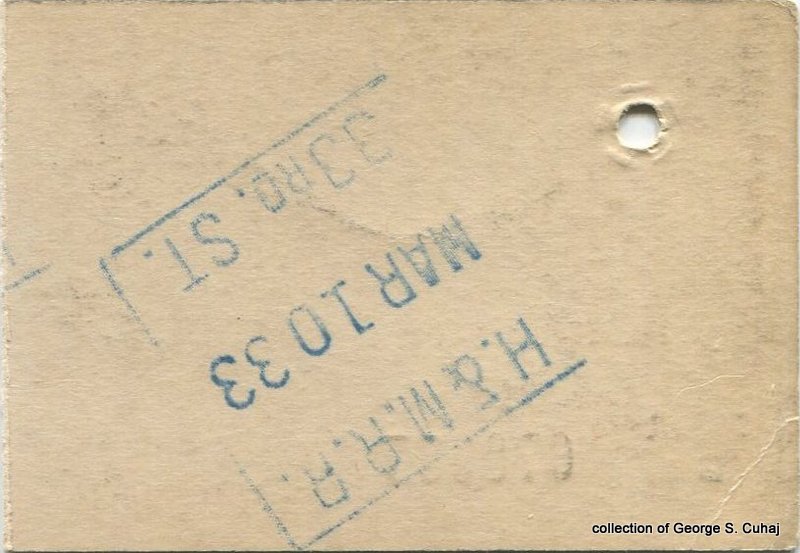 |
 |
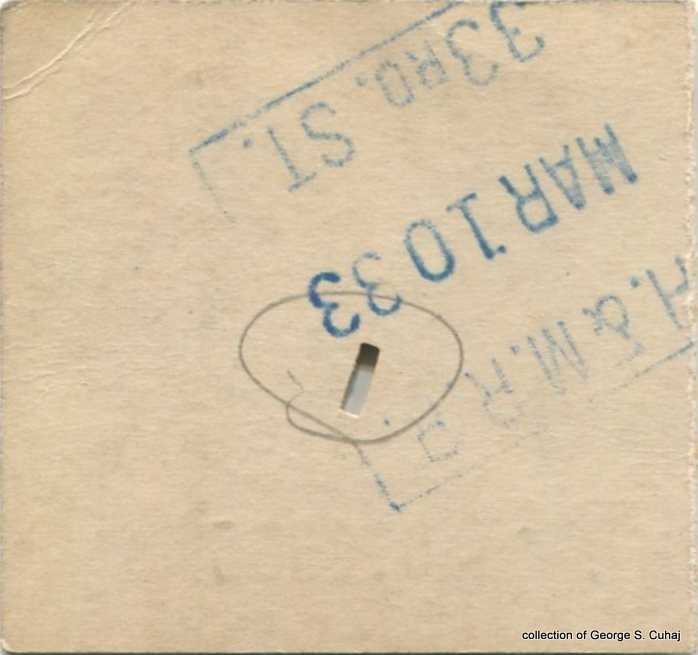 |
|
| 33rd Street Station, Manhattan, NY - March 10, 1933 C. D. Emmons, President Rand McNally 2 3/4" x 1 7/8" |
||||
| 30 Day Excursion | ||||
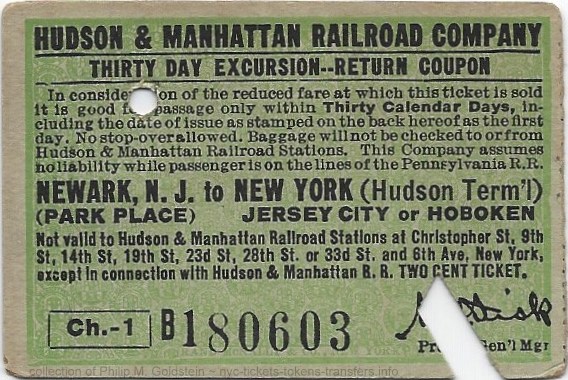 |
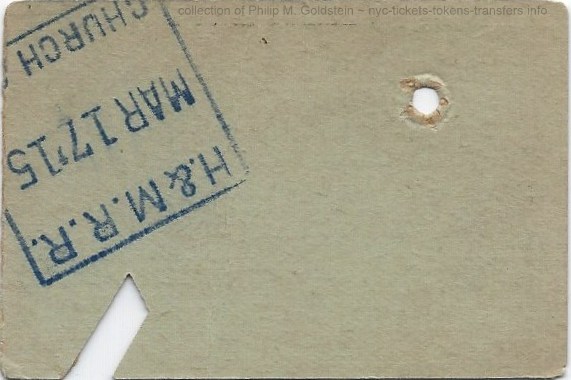 |
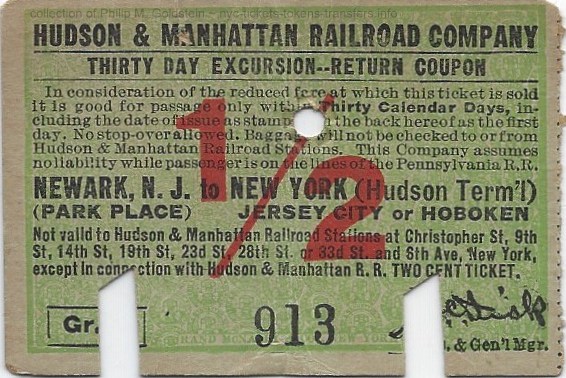 |
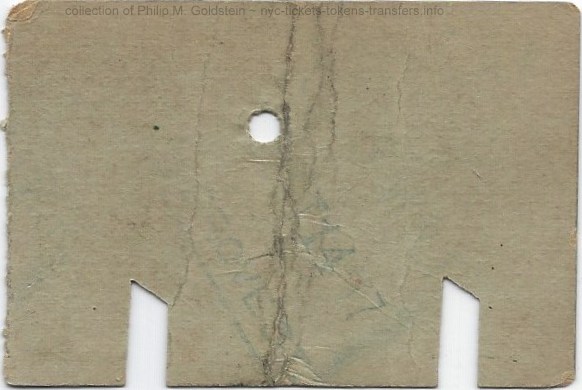 |
|
| Church Street Station, Manhattan, NY - March 17, 1915 Wilbur C. Fisk, President & General Manager Rand McNally 2 3/4" x 1 7/8" |
1/2 Fare Grove Street Station, NJ - October 14, 1917 Wilbur C. Fisk, President & General Manager Rand McNally 2 3/4" x 1 7/8" |
|||
| . . |
||||
| . | ||||
 |
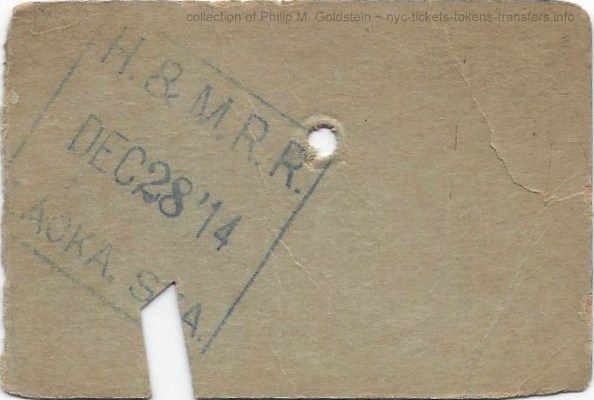 |
intentionally left blank | intentionally left blank | |
| Lackawanna Terminal - Hoboken, NJ - December 28, 1914 Wilbur C. Fisk, President & General Manager Rand McNally 2 3/4" x 1 7/8" |
||||
| . . |
||||
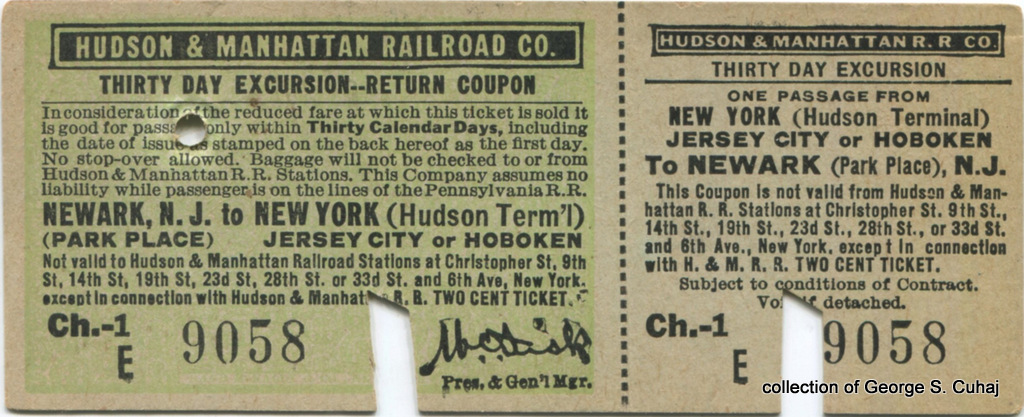 |
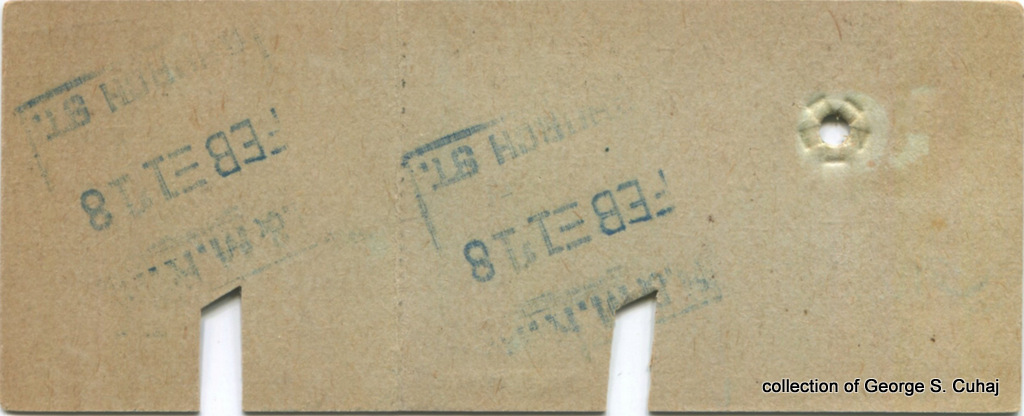 |
|||
| Church Street Station - February 1, 1918 P. Fisk, President & General Manager Rand McNally |
||||
| . | ||||
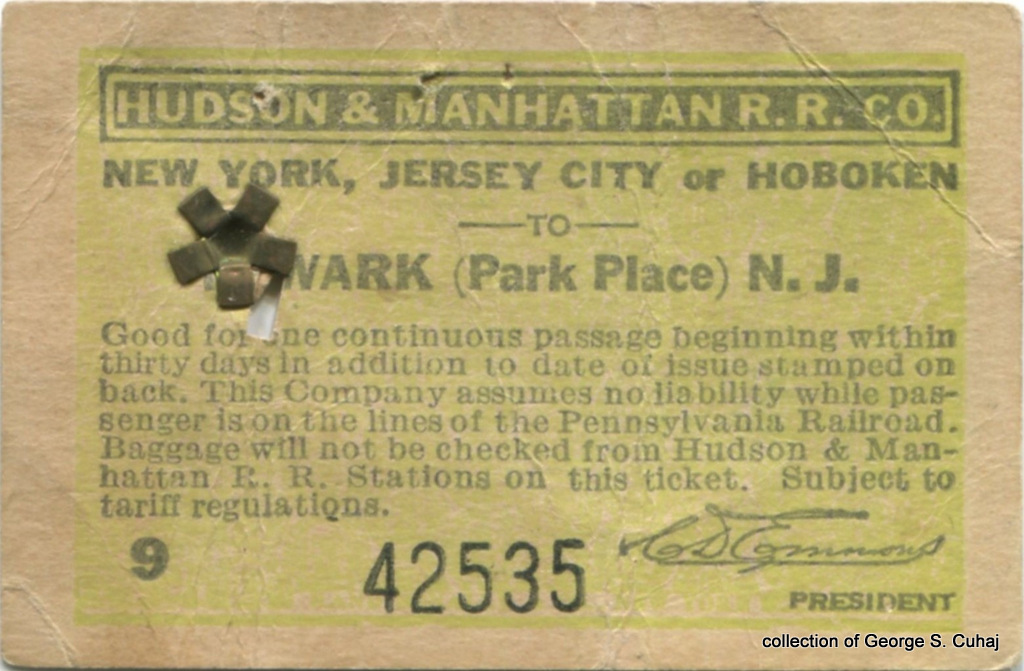 |
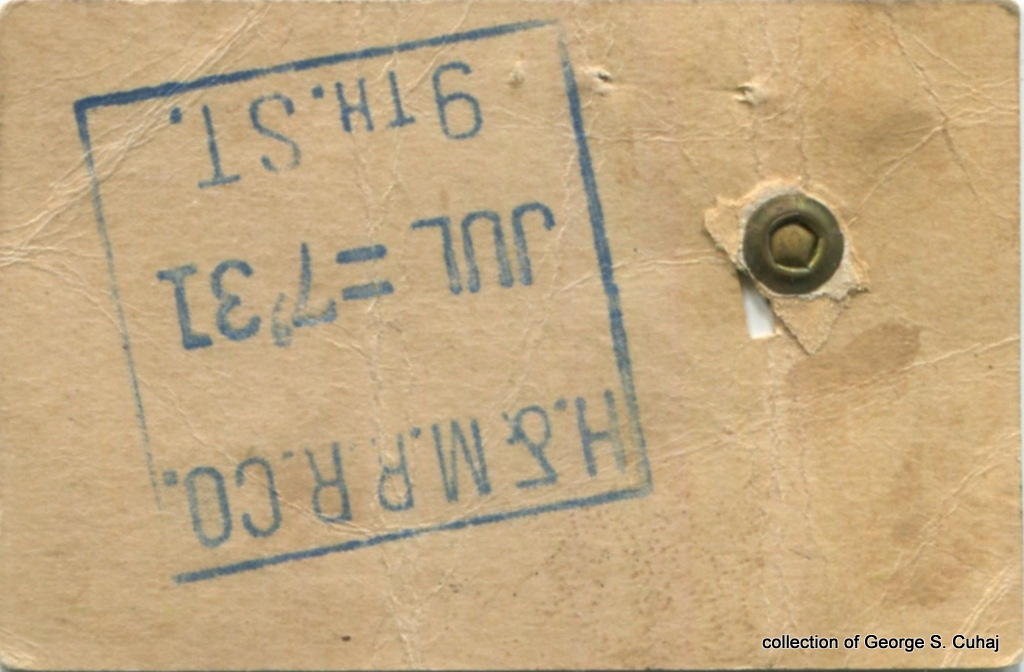 |
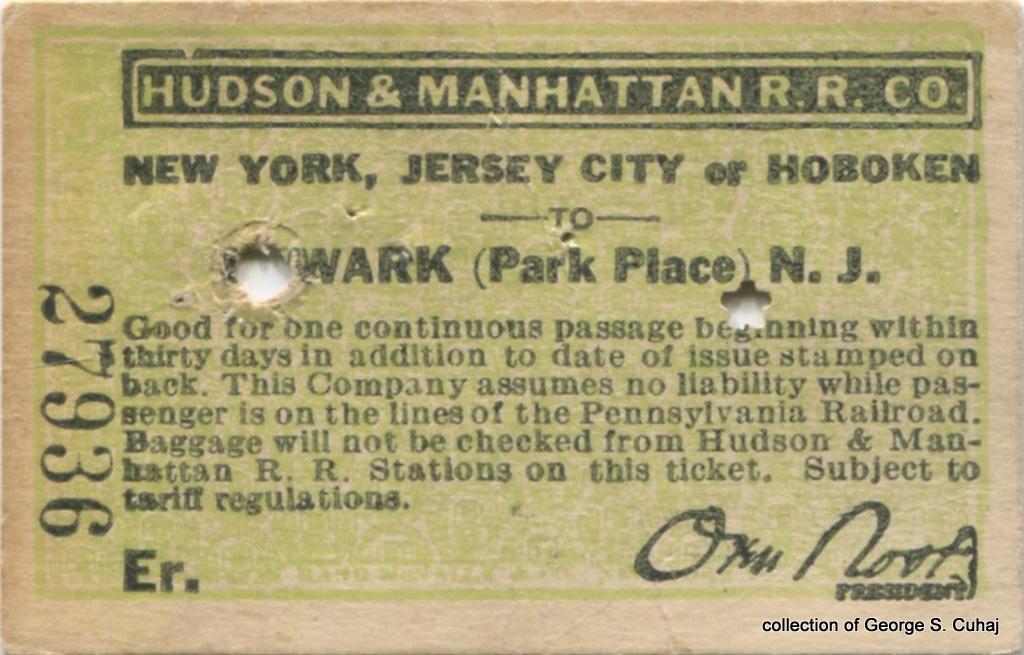 |
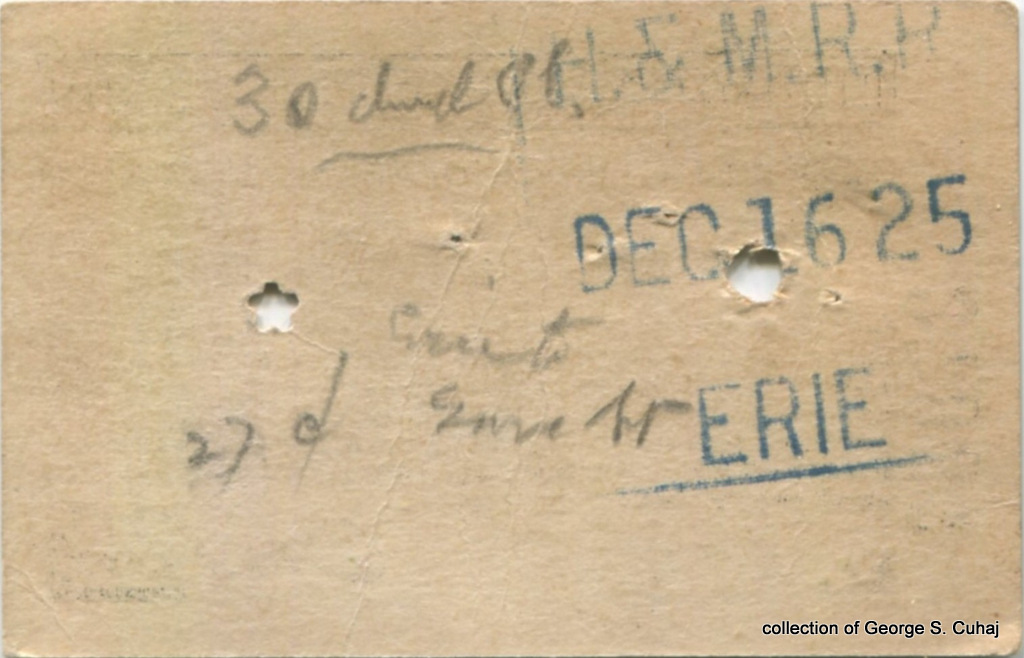 |
|
| 9th Street Station - July 7, 1931 C. D. Emmons, President Rand McNally |
Erie Terminal - December 16, 1925 Oren Root, President Rand McNally |
|||
| . | ||||
 |
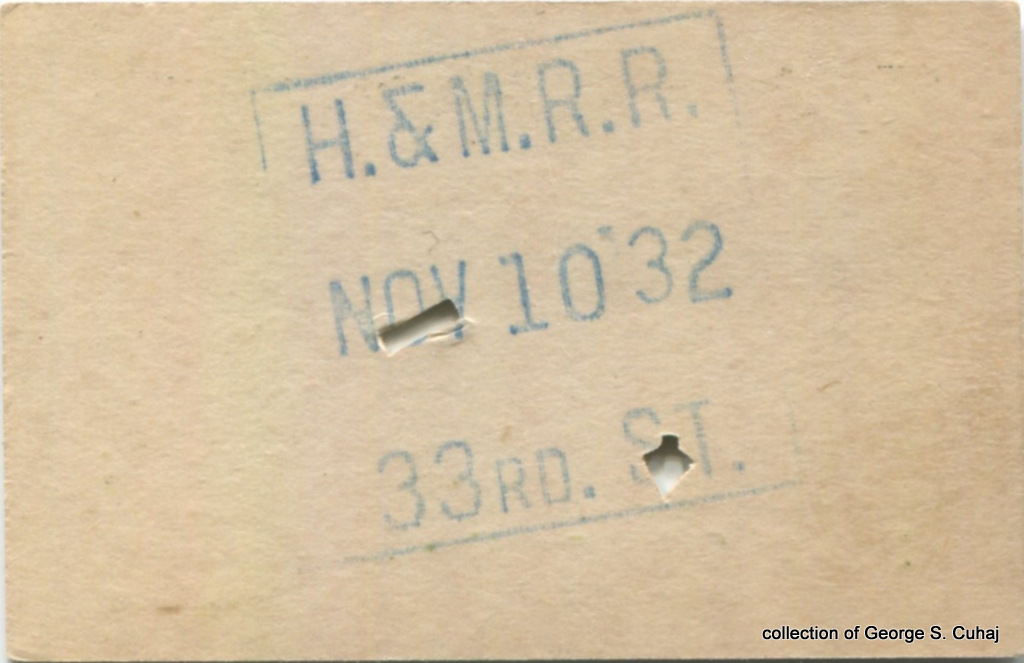 |
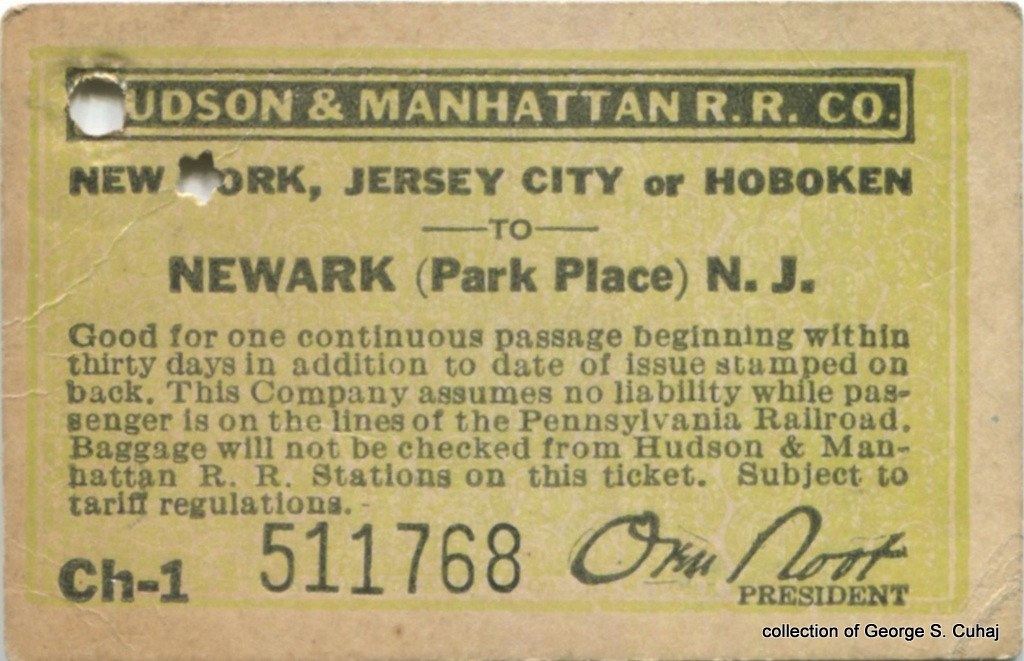 |
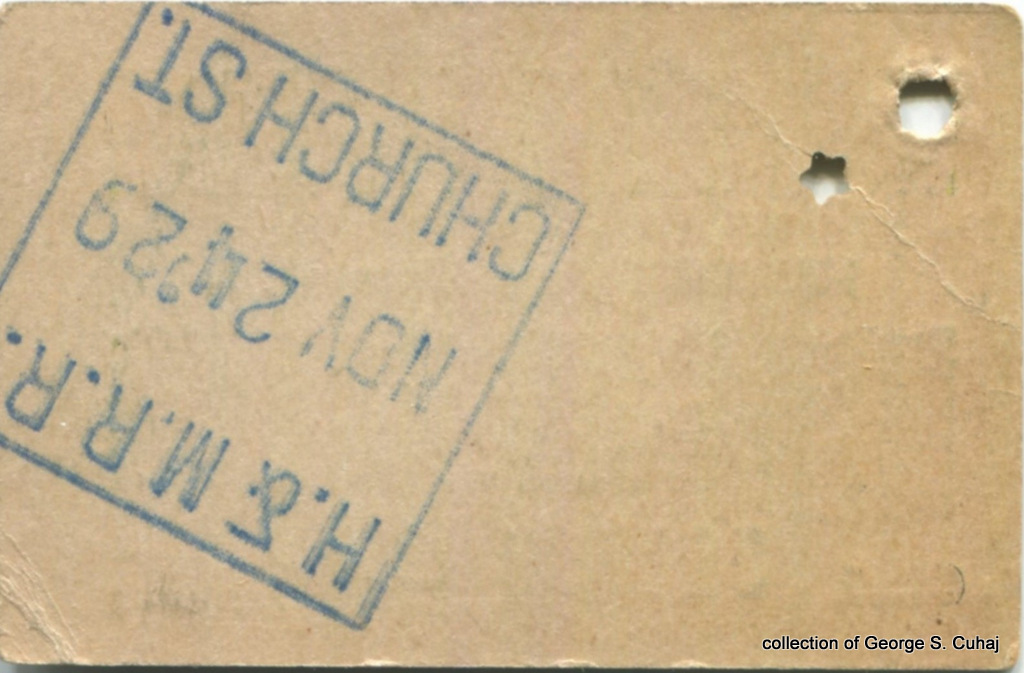 |
|
| 33rd Street Station - November 10, 1932 C. D. Emmons, President Rand McNally |
Church Street Station- November 24, 1929 Oren Root, President Rand McNally |
|||
| . | ||||
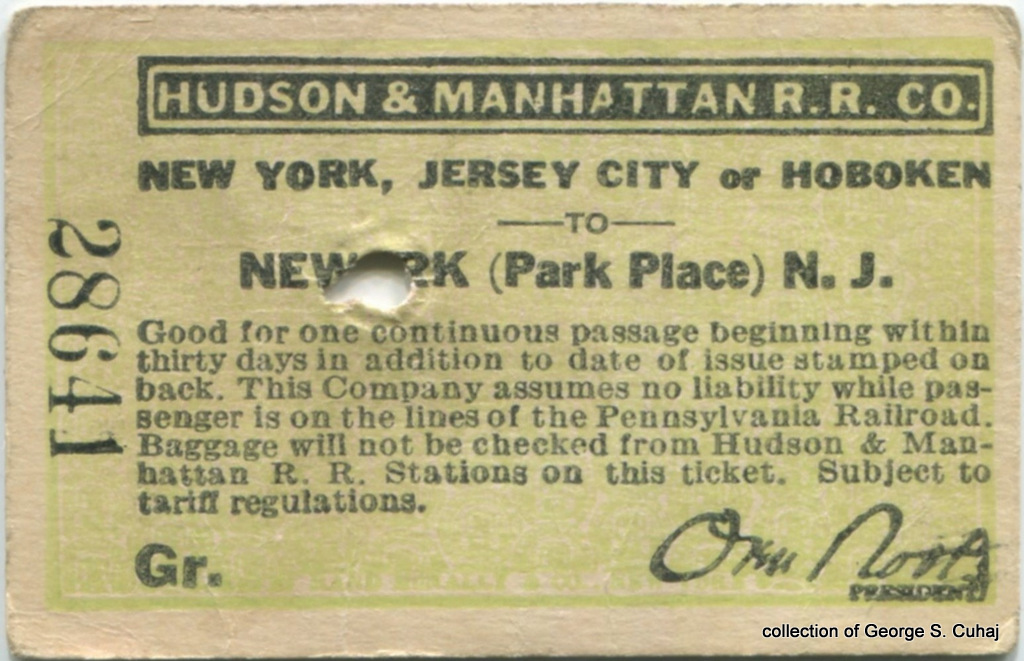 |
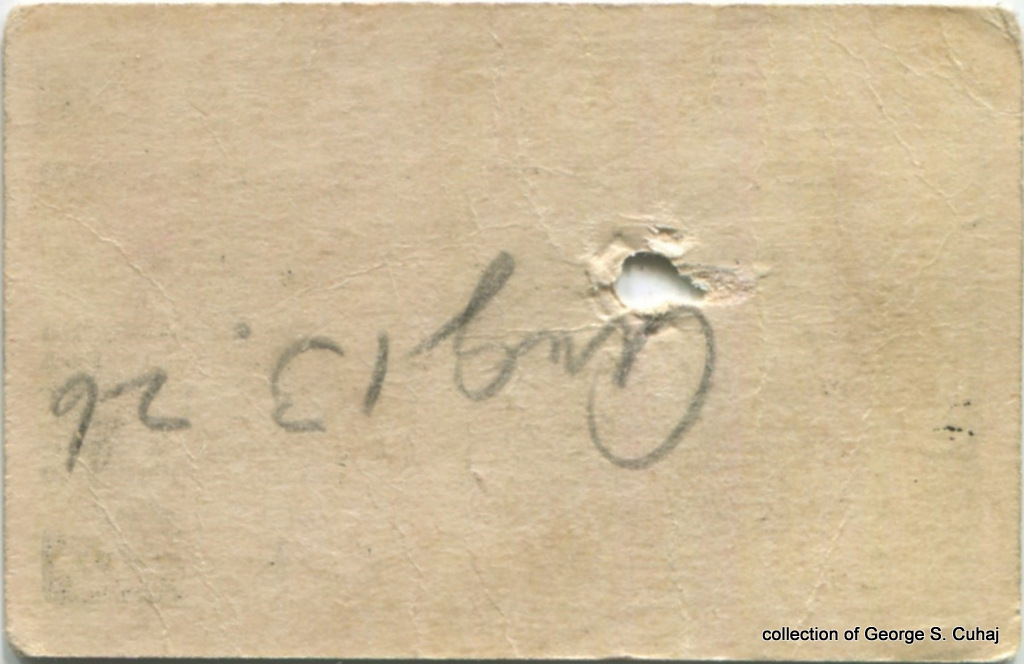 |
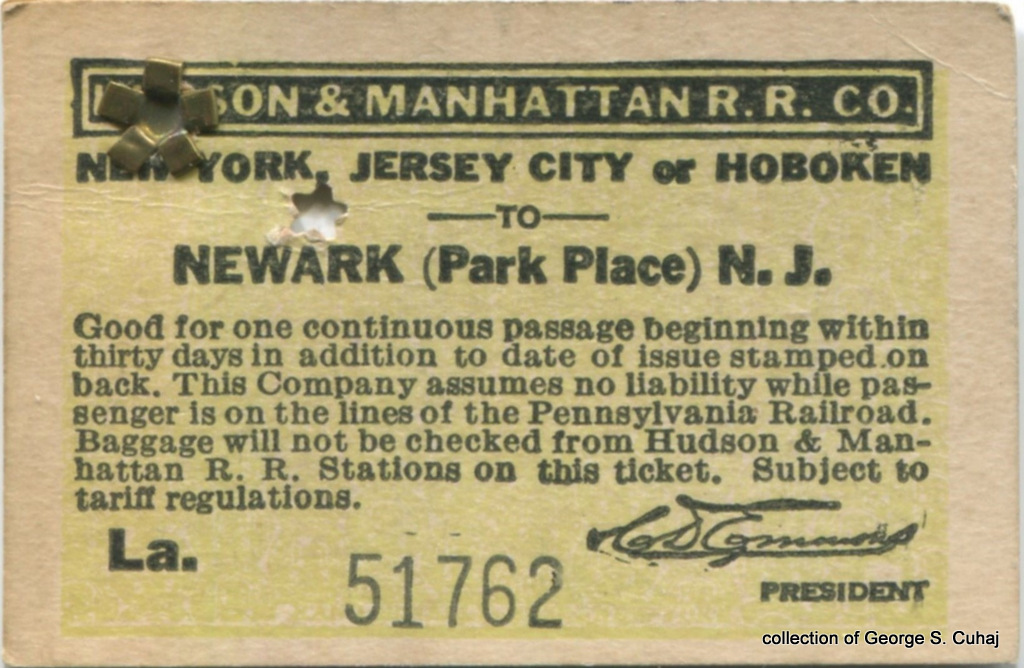 |
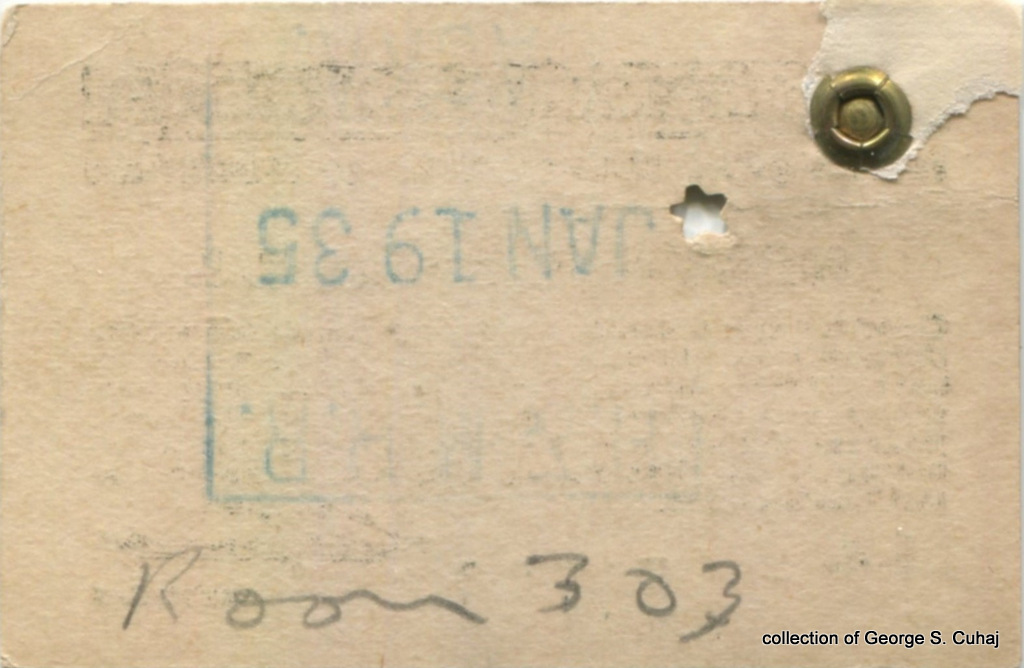 |
|
| Grove Street Station, NJ - August 13, 1926 Oren Root, President Rand McNally |
Lackawanna Terminal, NJ - January 19, 1935 C. D. Emmons, President Rand McNally |
|||
| . | ||||
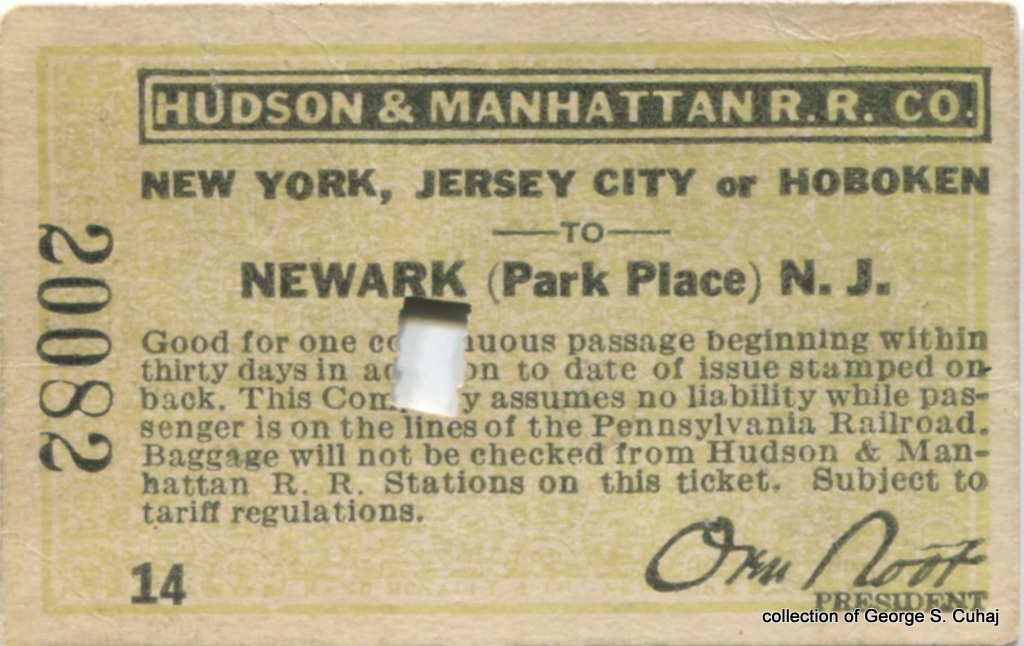 |
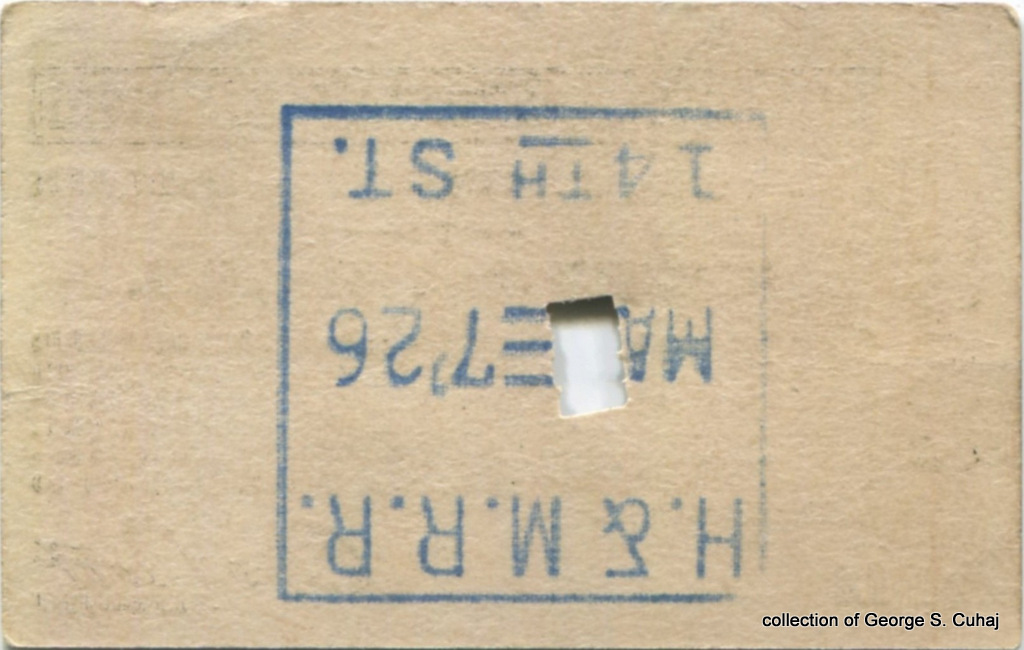 |
 |
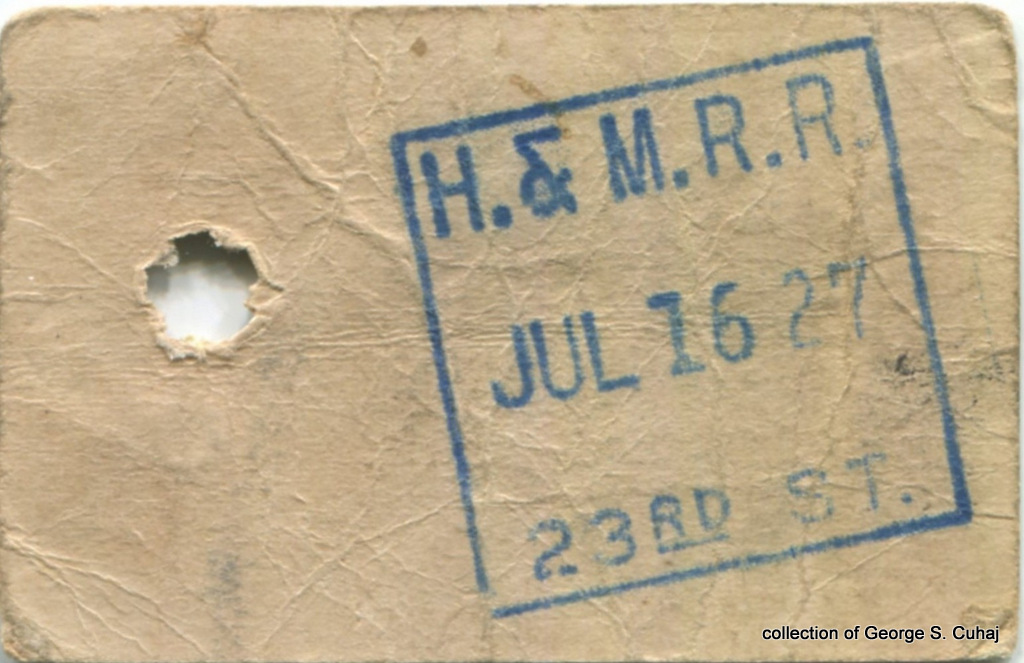 |
|
| 14 Street, Manhattan, NY - March or May 7, 1926 Oren Root, President Rand McNally |
23rd Street, Manhattan, NY - July 16, 1927 Oren Root, President Rand McNally |
|||
| . | ||||
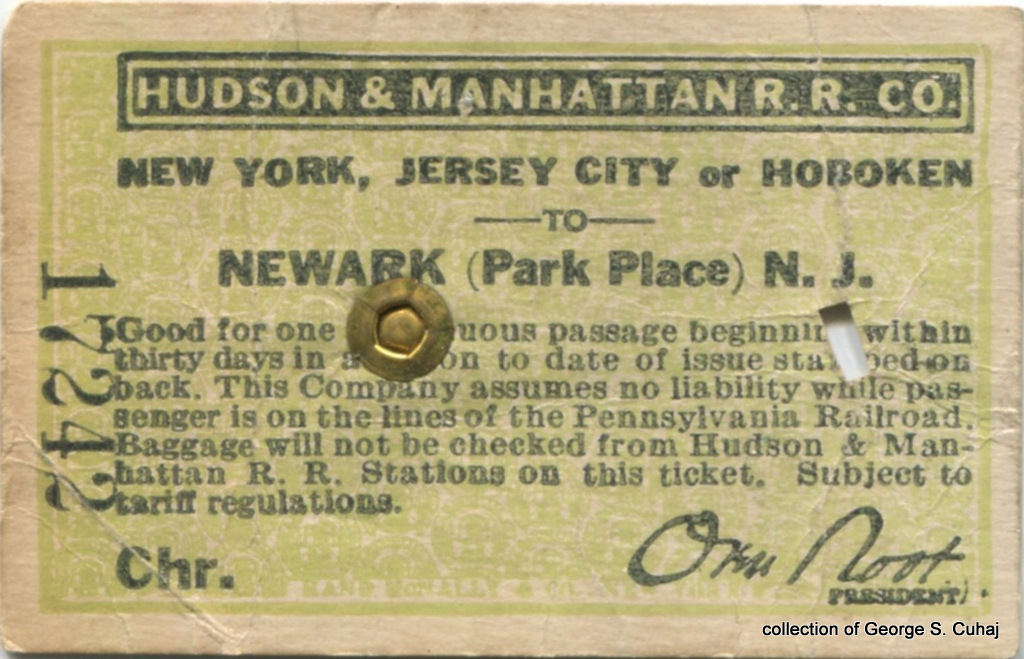 |
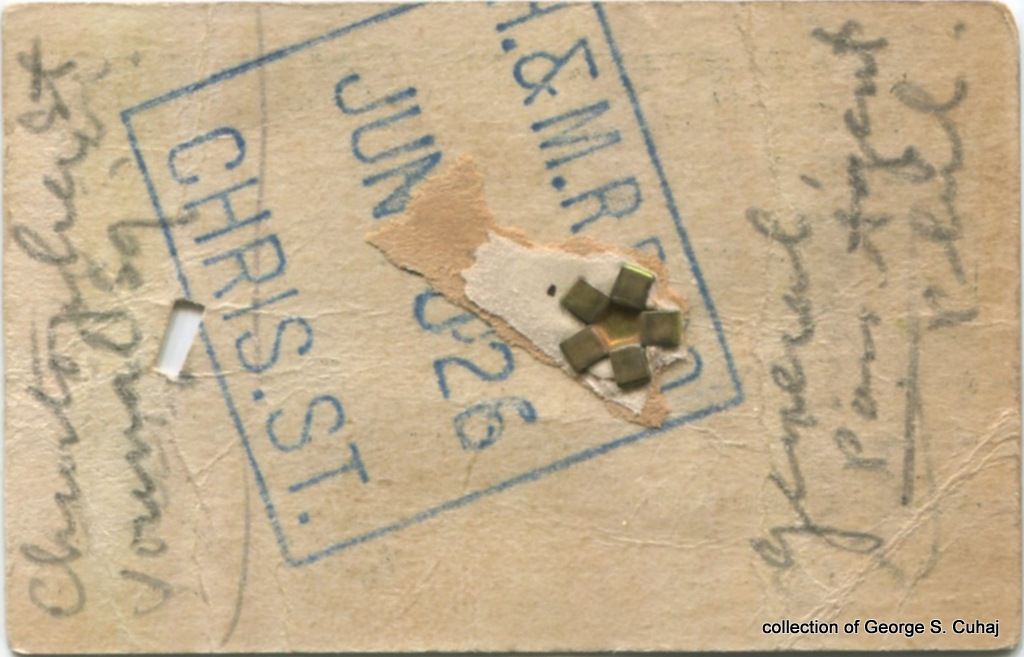 |
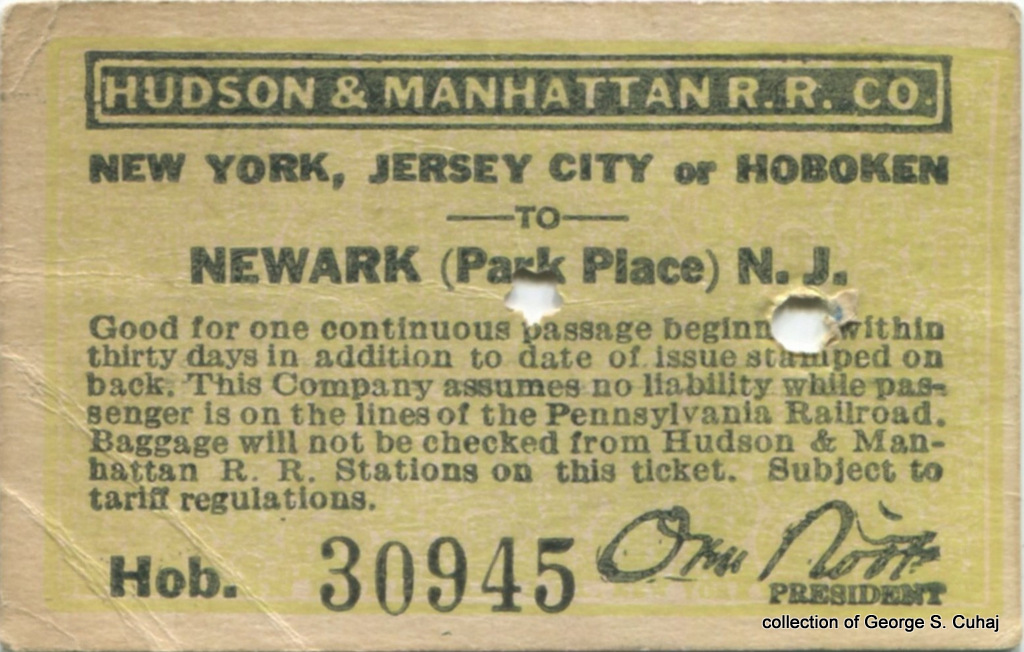 |
 |
|
| Christopher Street Station, Manhattan, NY - June 1926 Oren Root, President Rand McNally |
Hoboken Station, NJ - July 28, Oren Root, President Rand McNally |
|||
| . | ||||
 |
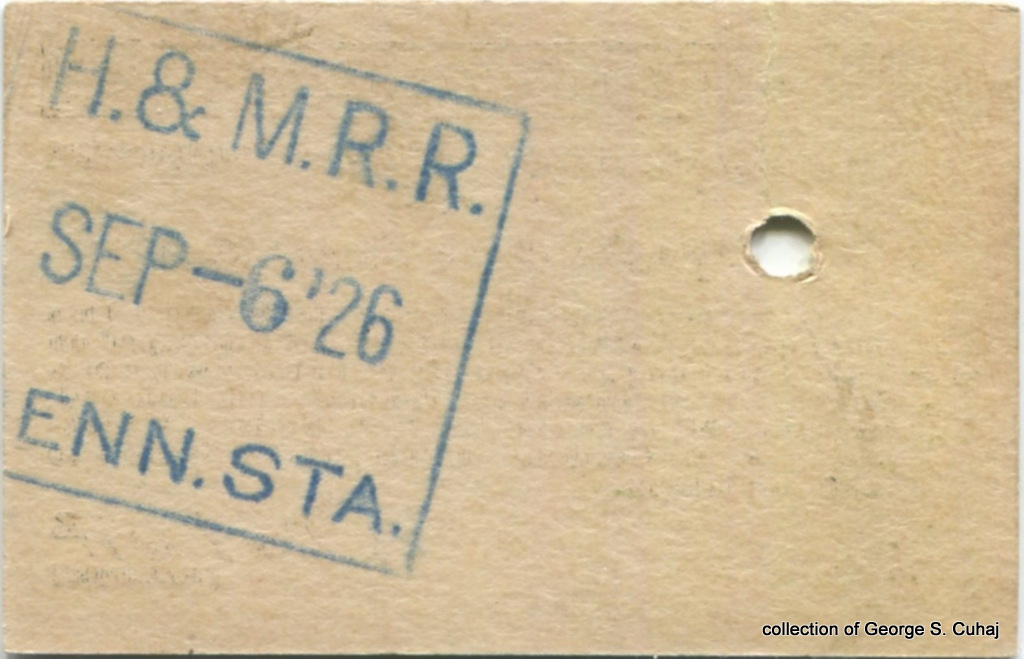 |
|||
| Pennsylvania Station, Manhattan, NY - September 6, 1926 Oren Root, President Rand McNally |
||||
| Good for One Year | ||||
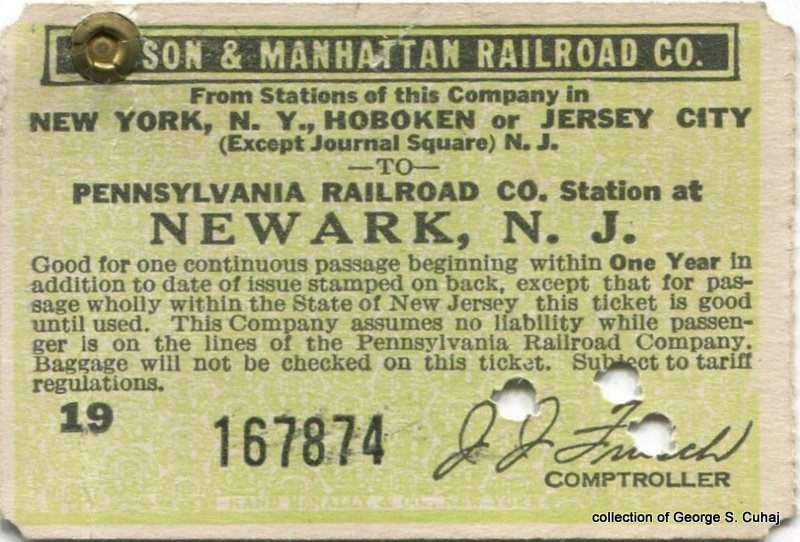 |
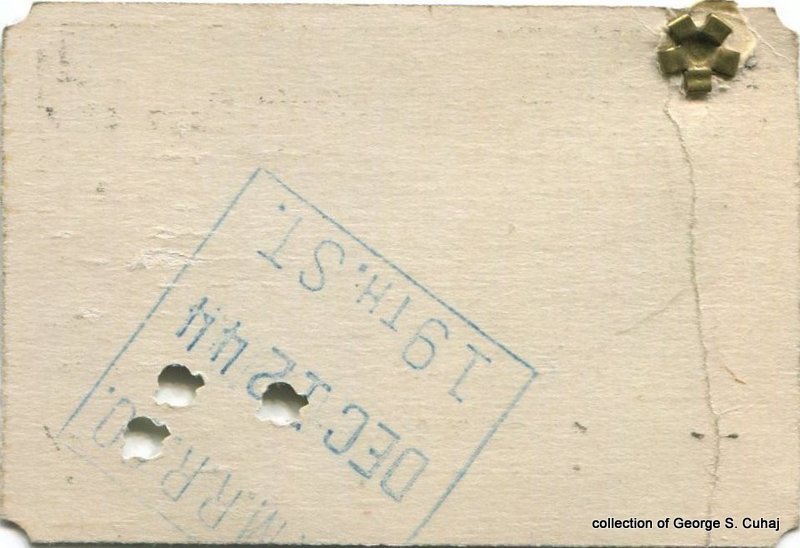 |
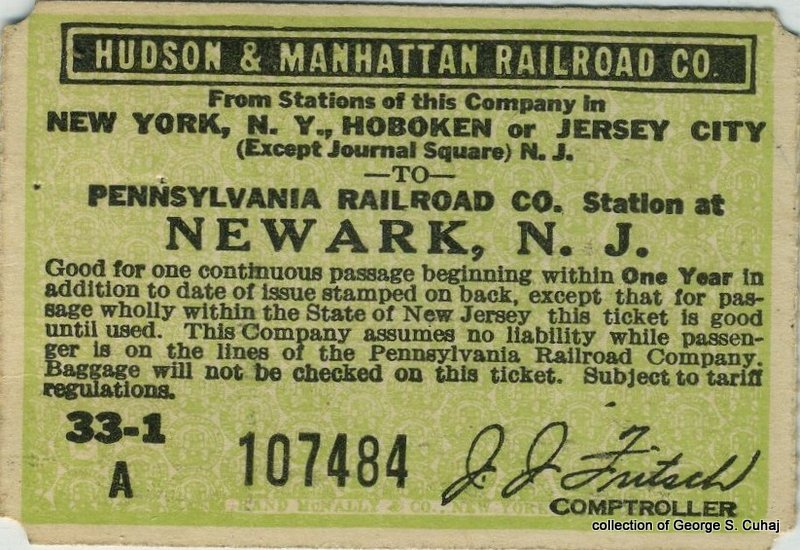 |
 |
|
| 19th Street Station, Manhattan, NY J. J. Fritsch, Comptroller Rand McNally 2 3/4" x 1 7/8" |
33rd Street Station, Manhattan, NY - unoknown date J. J. Fritsch, Comptroller Rand McNally 2 3/4" x 1 7/8" |
|||
| First Class | ||||
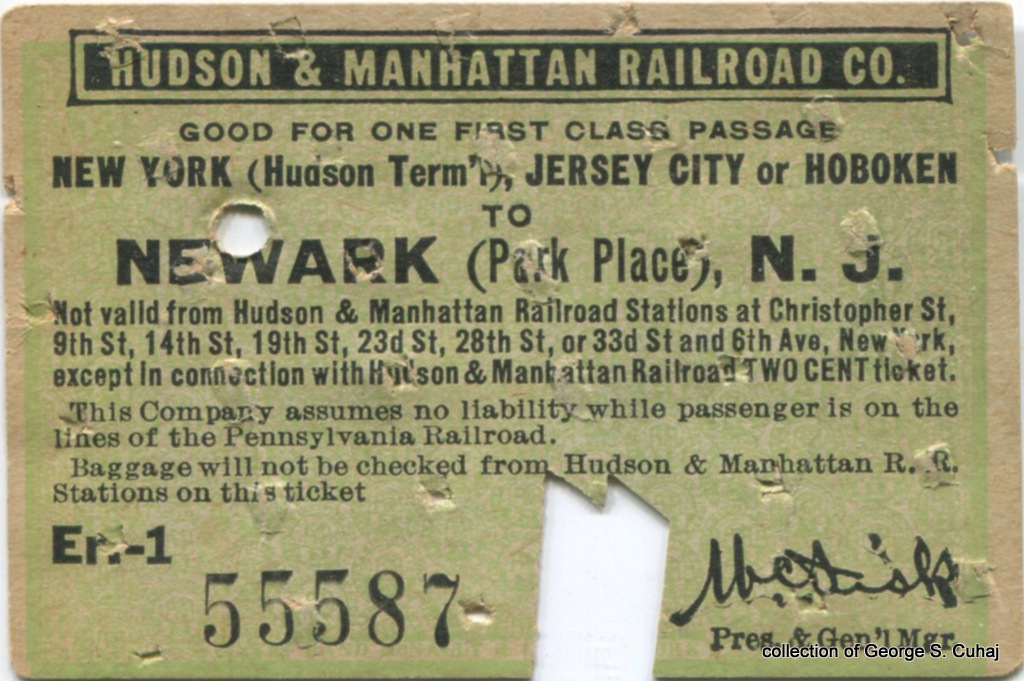 |
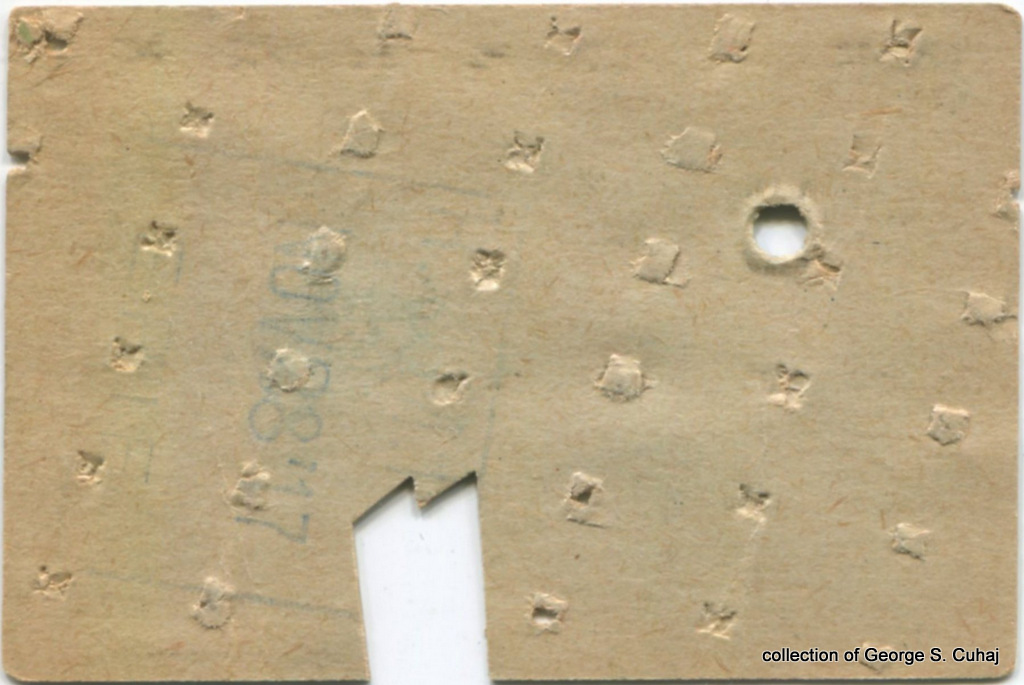 |
 |
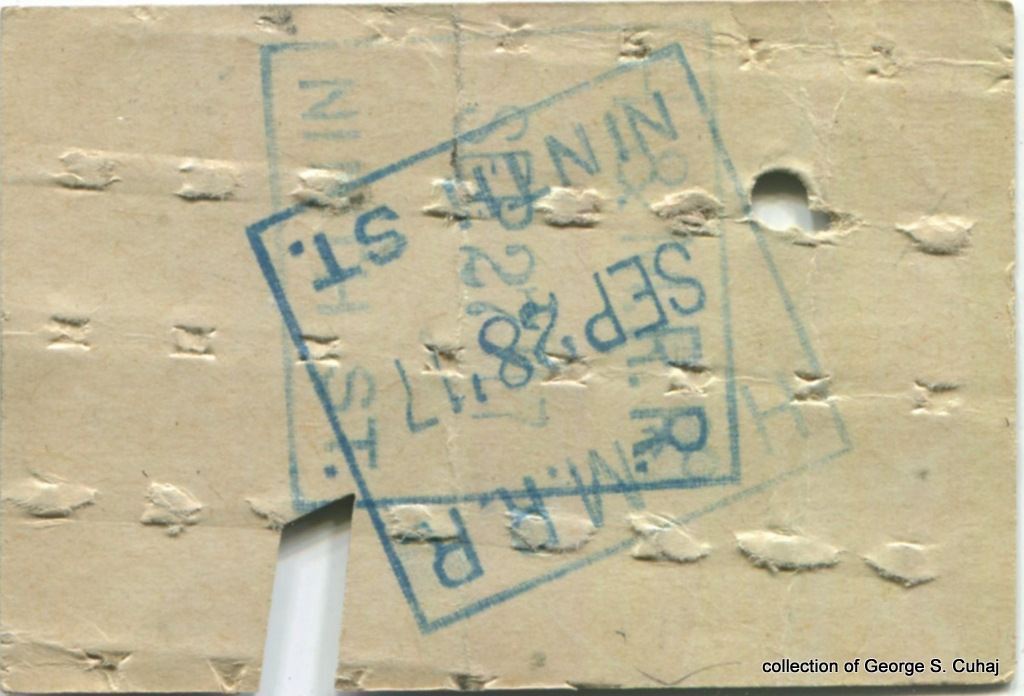 |
|
| Erie Terminal - November 28, 1917 Wilbur C. Fisk, President & General Manager Rand McNally |
9th Street Station - September 28, 1917 Wilbur C. Fisk, President & General Manager Rand McNally |
|||
| . | ||||
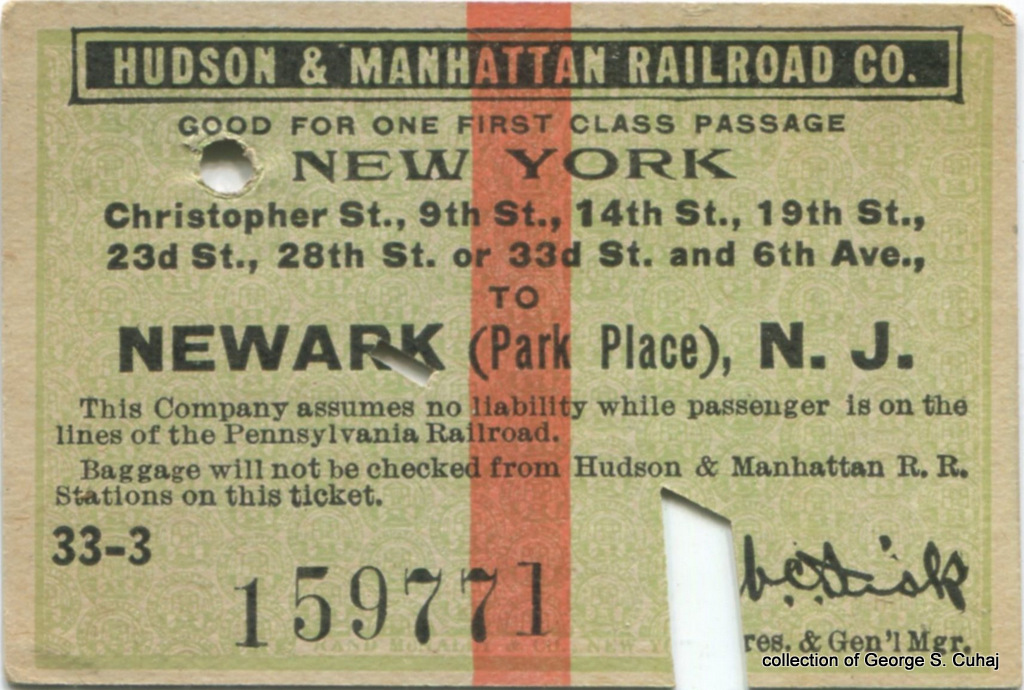 |
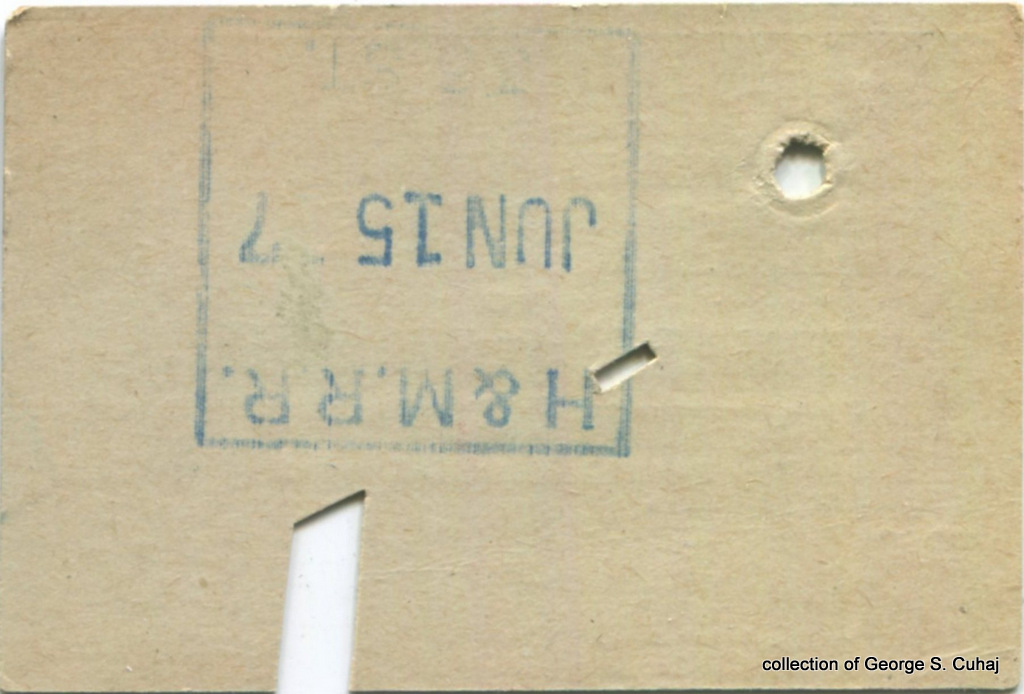 |
|||
| 33rd Street, Manhattan, NY Wilbur C. Fisk, President & General Manager Rand McNally |
||||
Receipts |
||||
 |
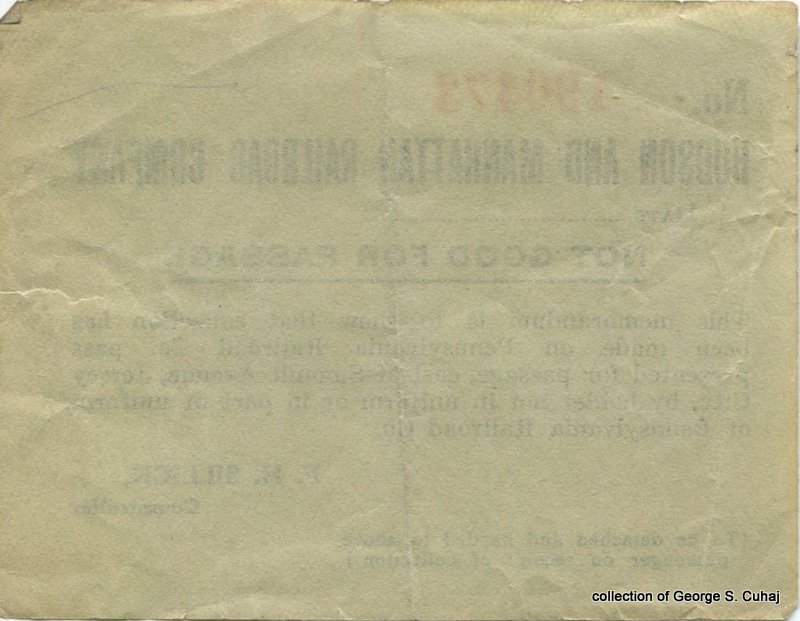 |
|||
| F. H. Sillick; Comptroller | ||||
| Pennsylvania RR Coupon for travel from Newark to Harrison | Joint receipt issued by
the Pennsylvania Railroad to show that a passenger has paid the
extra fare for travel on the Hudson & Manhattan Railroad line. |
 4 1/16" x 1 3/16" |
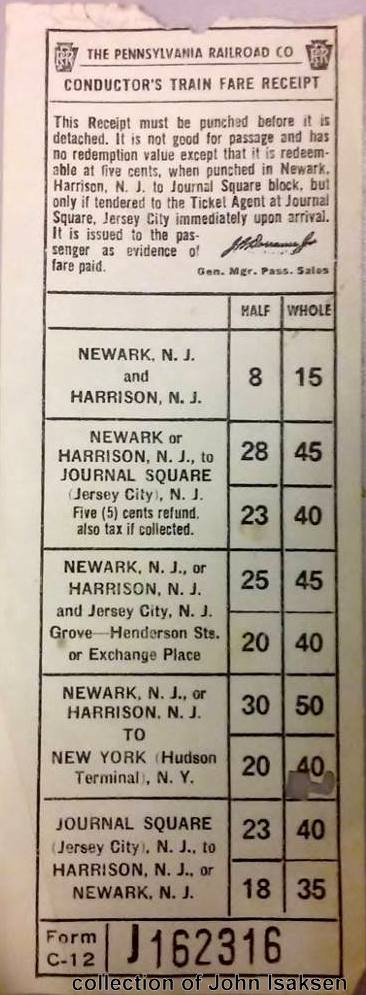 4 7/8" by 1 3/4" |

| New Jersey Issues | ||
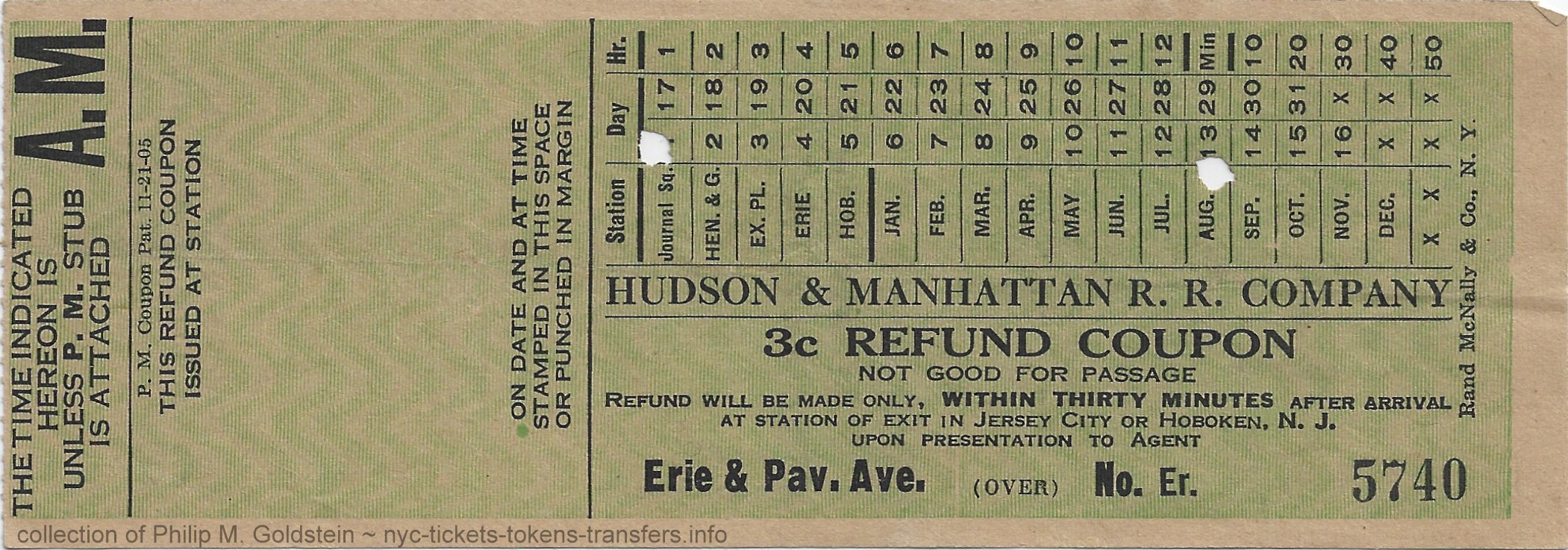 |
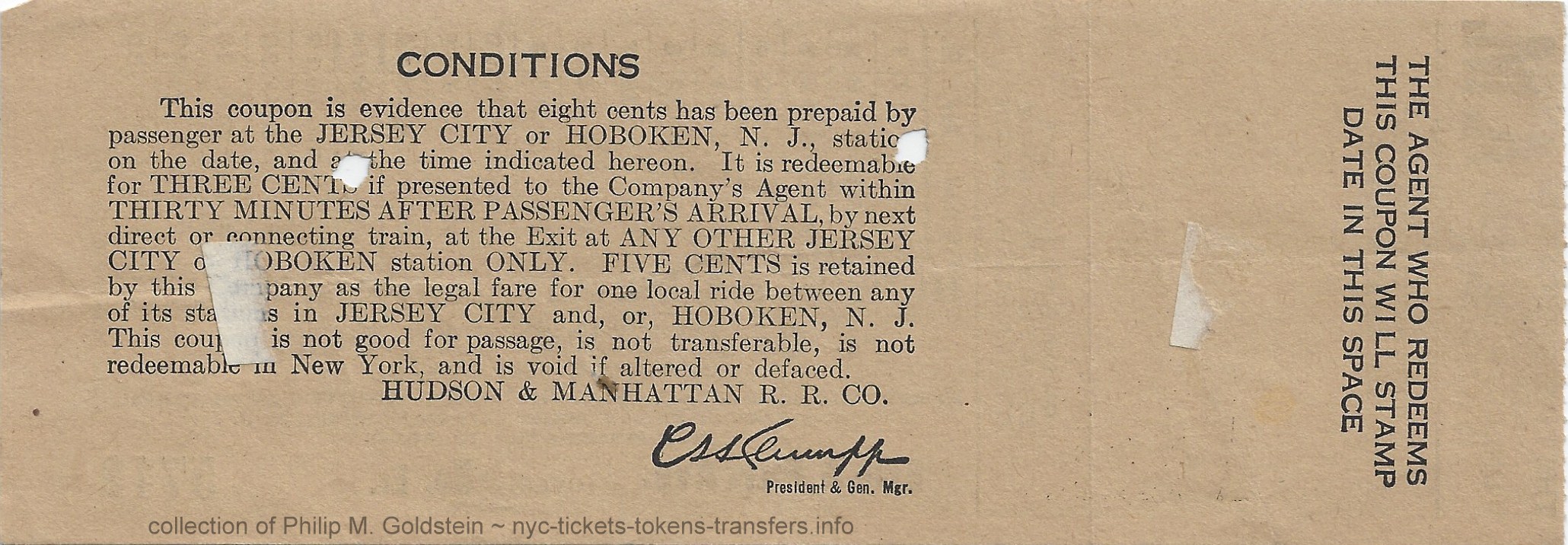 |
|
| 3 cent refund coupon - August 1 (ca. 1938-1941) Erie & Pavonia Avenue Station C. S. Klumpp, President & General Manager Rand McNally & Co. |
||
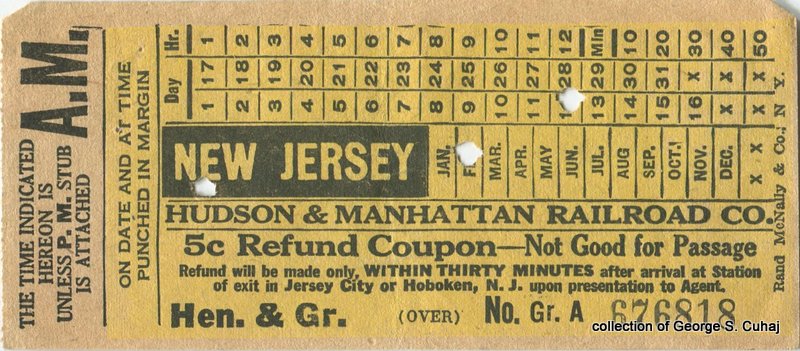 |
..... |
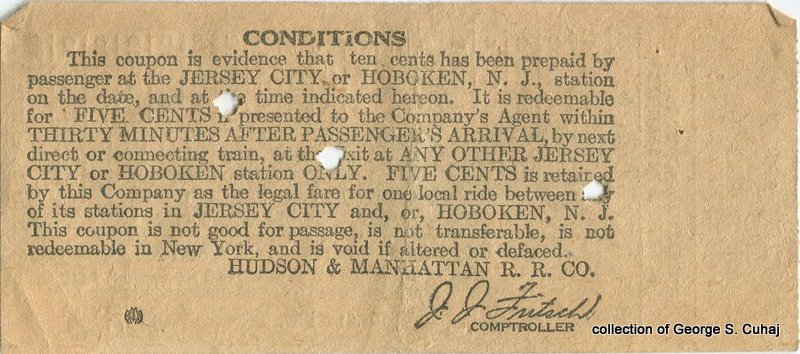 |
| 5 cent refund coupon - February 12 (pre-1951) Henderson Street / Grove Street Station J. J. Fritsch, comptroller Rand McNally & Co. |
||
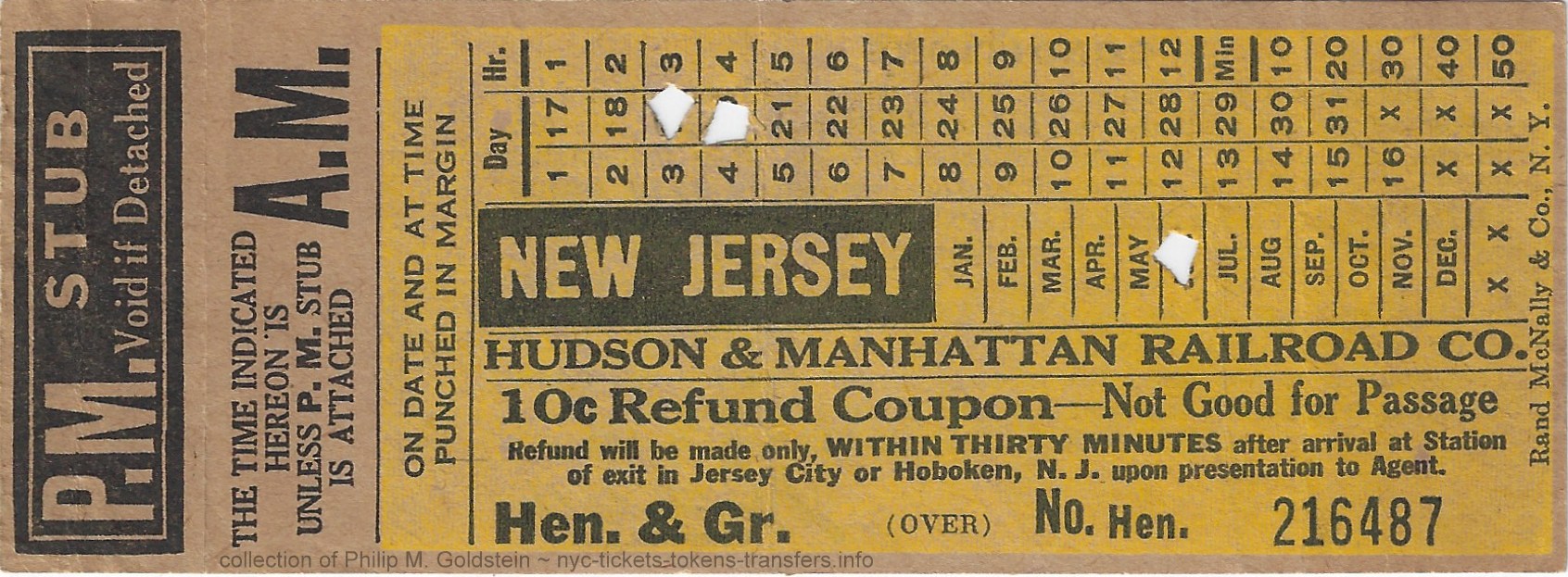 |
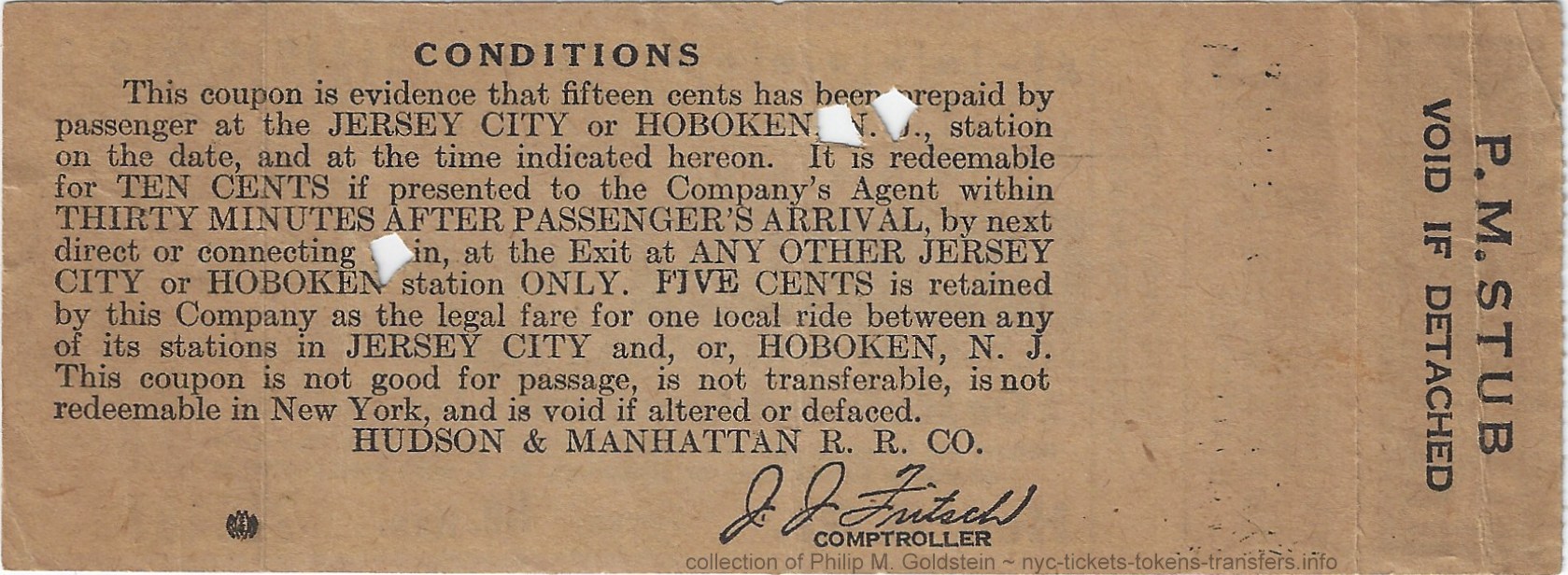 |
|
| 10 cent refund coupon June 19/20 (post-1951) Henderson Street / Grove Street Station Rand McNally & Co. J. J. Fritsch, comptroller 5 7/16" x 2" w/ PM stub |
||
| . . |
||
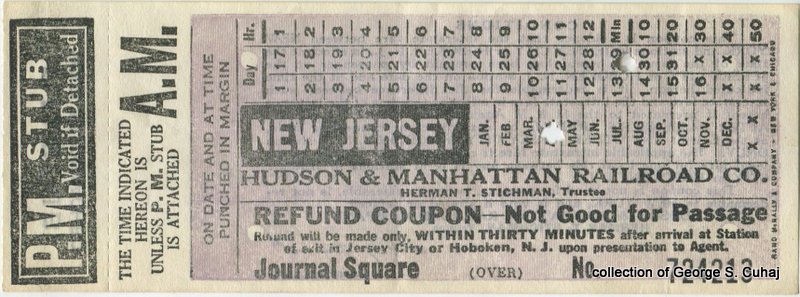 |
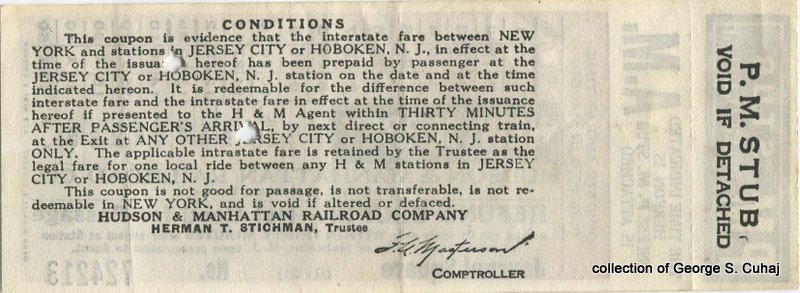 |
|
| Refund Coupon - April 29 (ca. 1956) Journal Square Herman T. Stichman, trustee F. U. Masterson, comptroller Rand McNally & Company |
||
| . . |
||
| New York Issues | ||
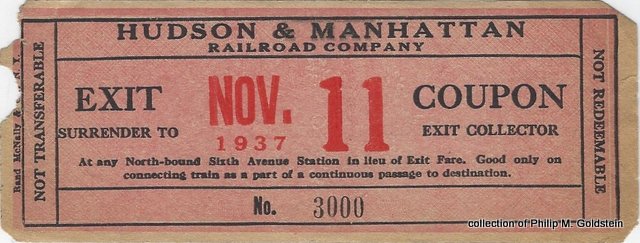 |
||
| November 11, 1937 | ||
| . . |
||
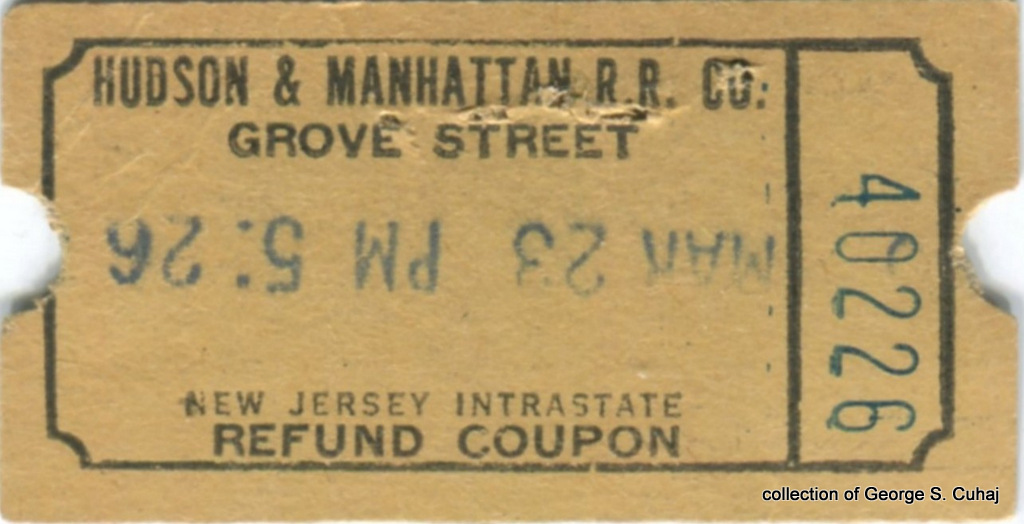 |
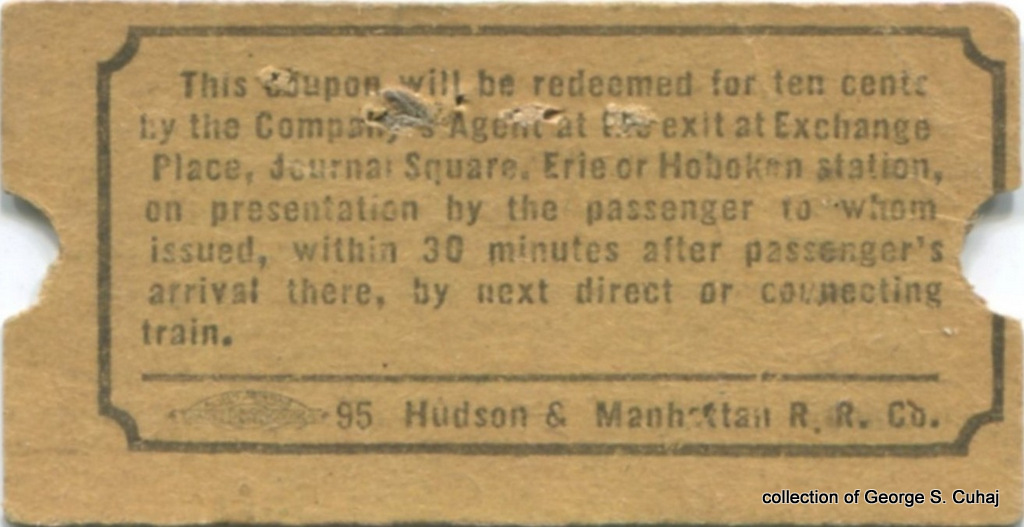 |
|
| No Series and Series A - Annual General Issue | |
 |
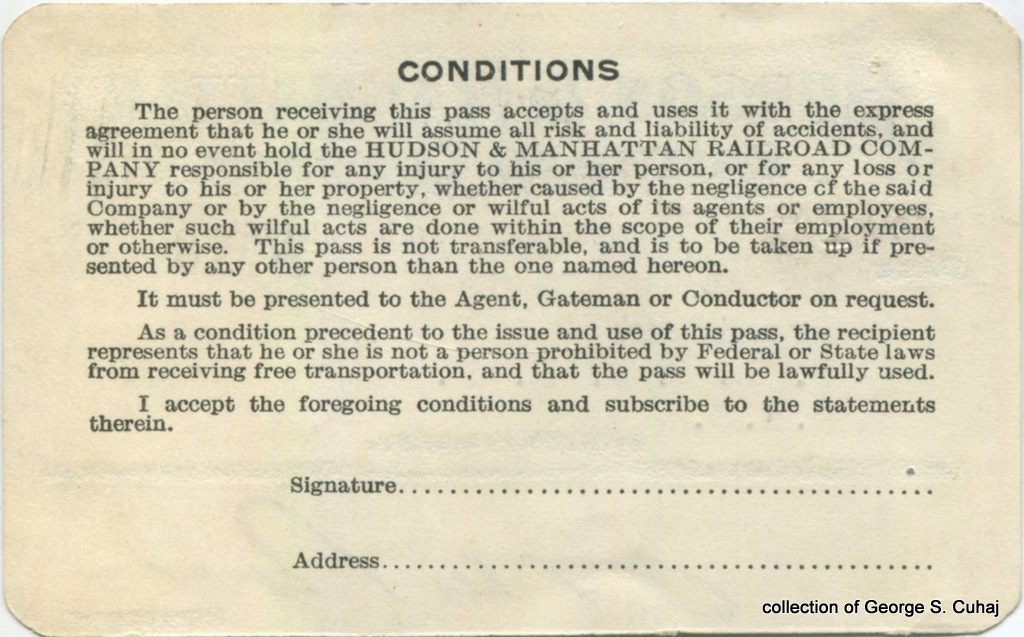 |
| Mr. J. M. Davis; President Delaware, Lackawanna & Western Railroad - 1928 Oren Root, President Rand McNally |
|
| . . |
|
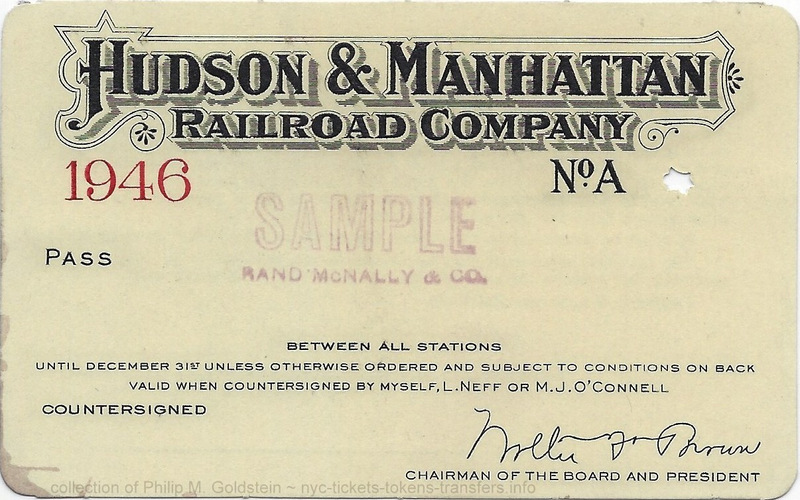 |
 |
| A - 1946 Walter F. Brown, Chairman of the Board and President Rand McNally sample |
|
| . . |
|
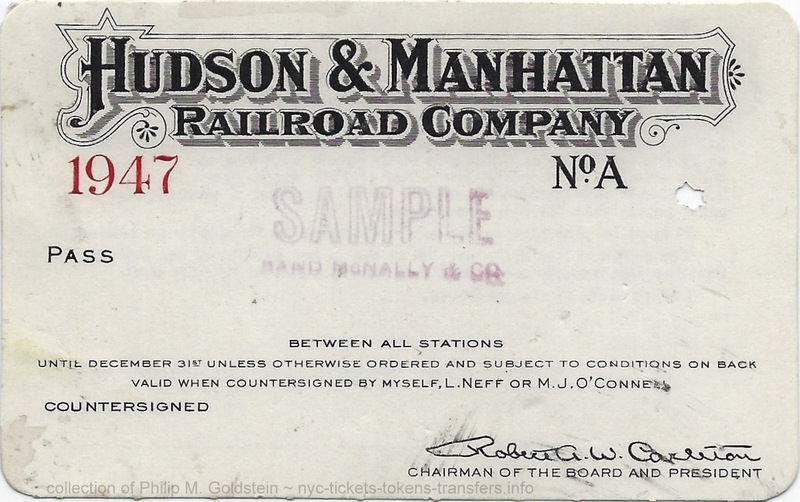 . . |
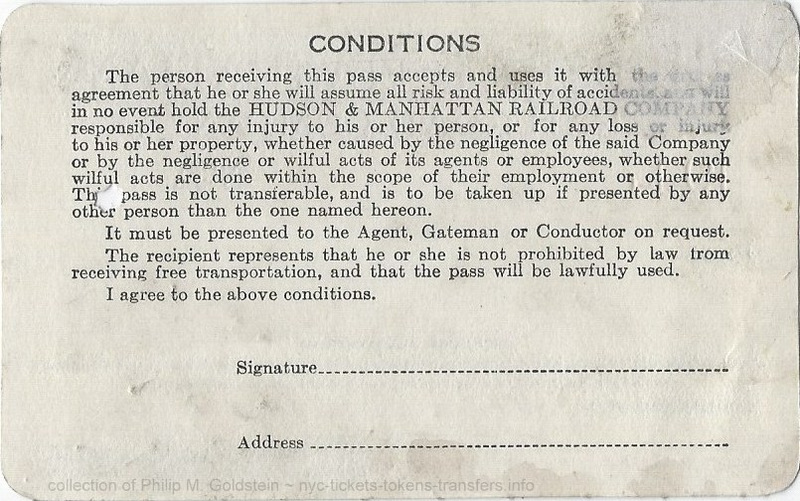 |
| A - 1947 Robert A. W. Carleton, Chairman of the board and President Rand McNally sample |
|
Series E - Employee |
|
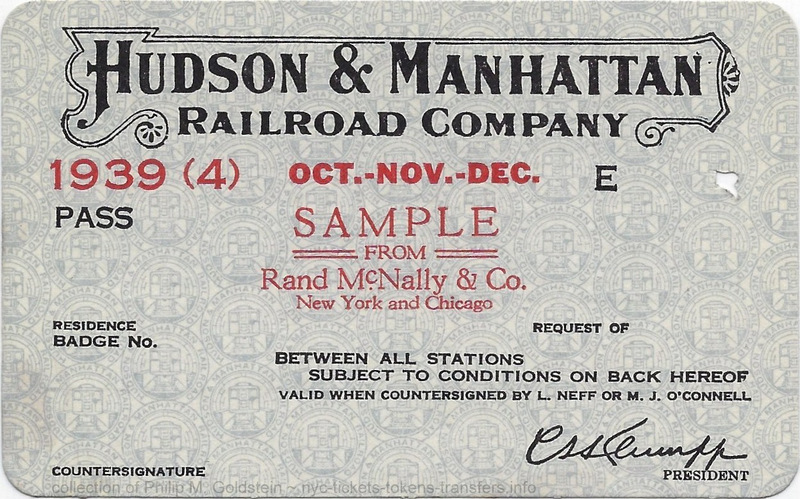 |
 |
| 1939 (4) October, November, December C. S. Klumpp, President Rand McNally & Company sample |
|
| . . |
|
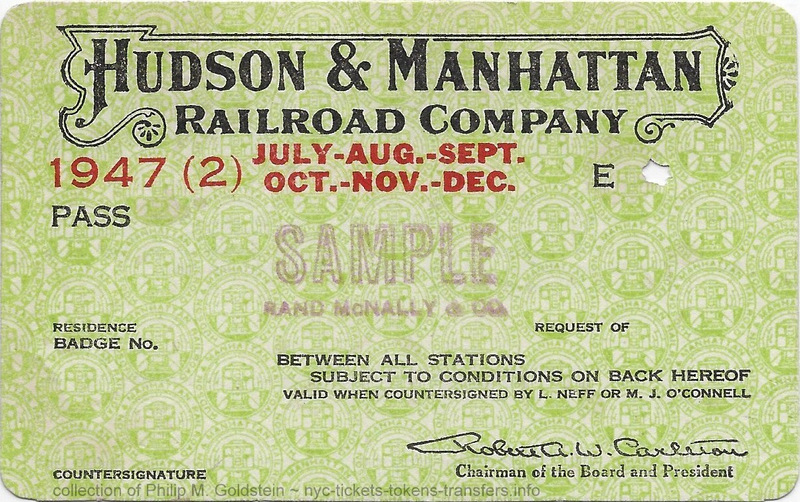 |
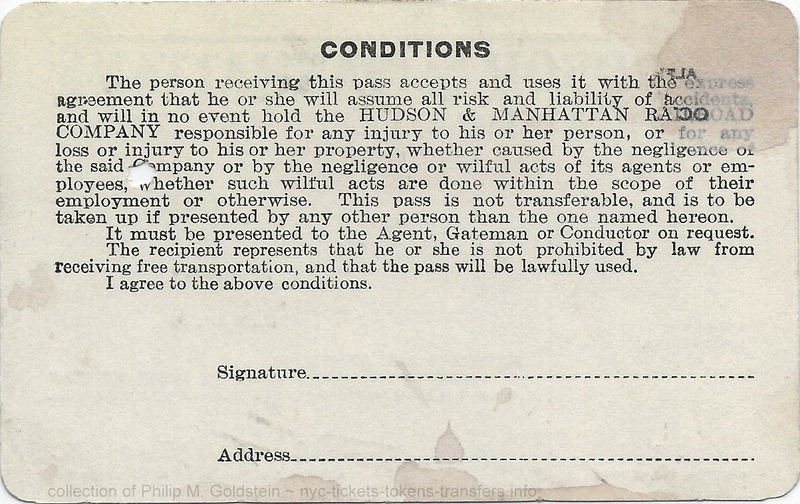 |
| 1947 (2) July, August, September, October, November, December Robert A. W. Carleton, Chairman of the board and President Rand McNally & Company sample |
|
Series EW - Employees Wife |
|
 |
 |
| 1939 (1) January, February, March C. S. Klumpp, President Rand McNally & Company sample |
|
| . . |
|
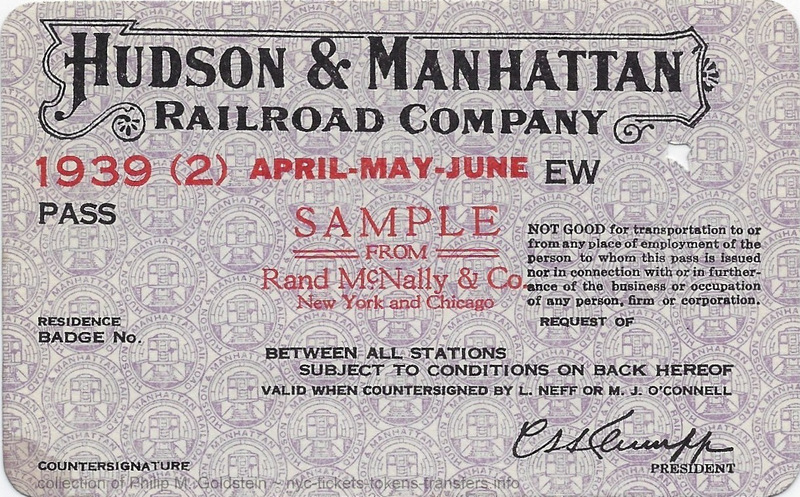 |
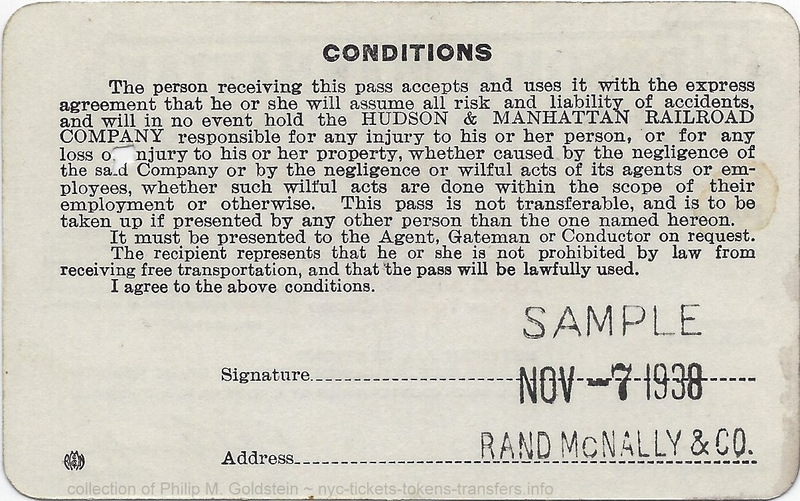 |
| 1939 (2) April, May, June C. S. Klumpp, President Rand McNally & Company sample |
|
| . . |
|
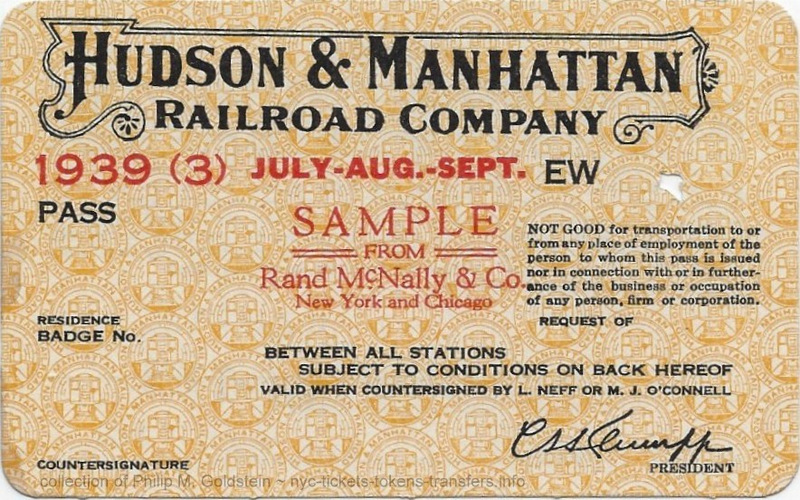 |
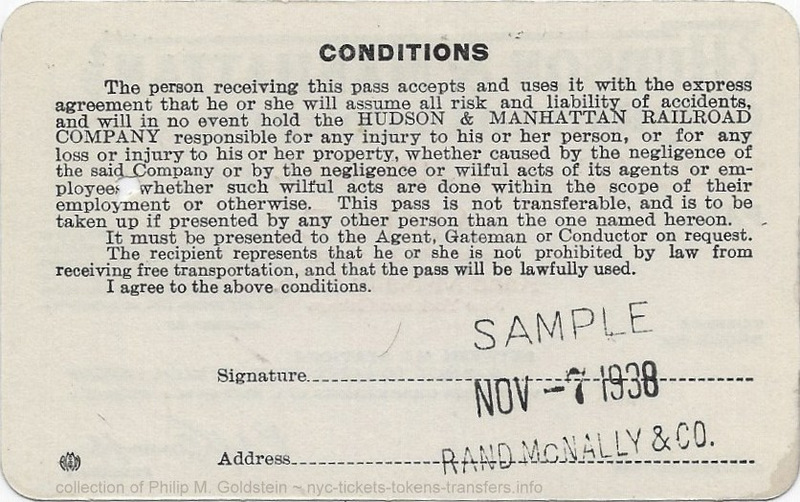 |
| 1939 (3) July, August, September C. S. Klumpp, President Rand McNally & Company sample |
|
| . . |
|
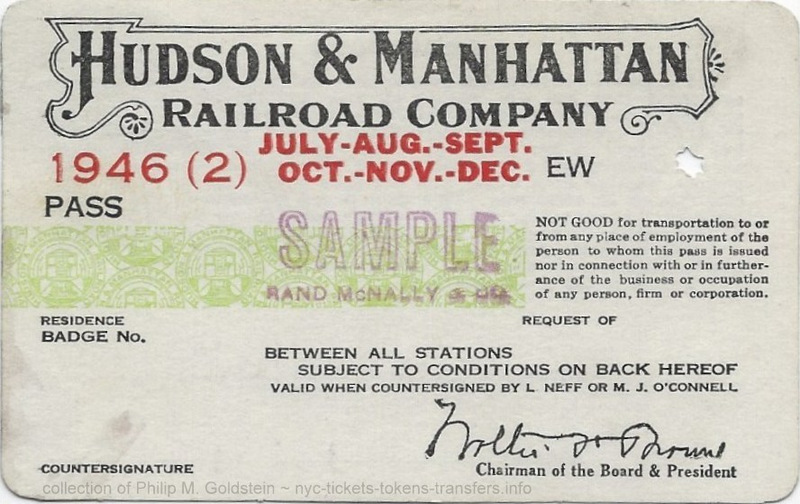 |
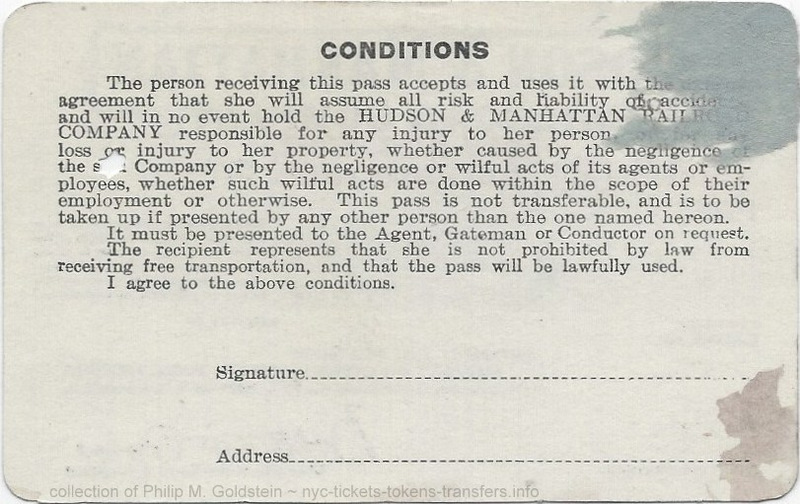 |
| 1946 (2) July, August, September, October, November, December Walter F. Brown, Chairman of the Board and President Rand McNally & Company sample |
|
Series WX - Womens unknown |
|
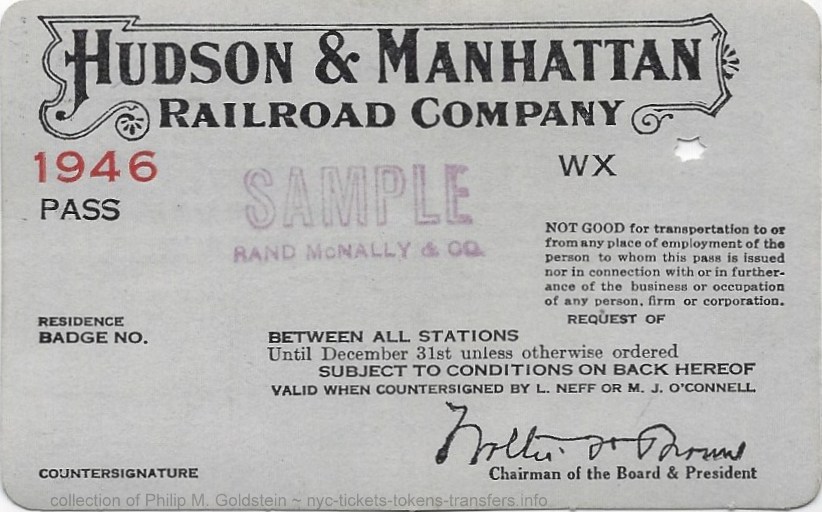 |
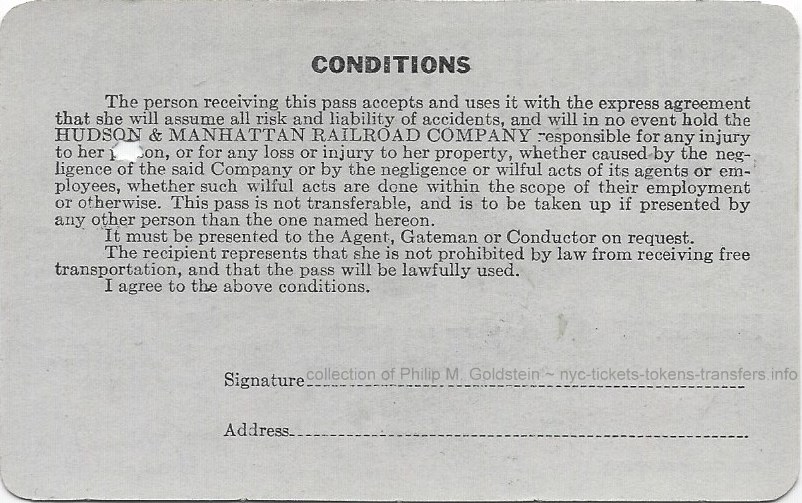 |
| 1946 - WX Walter F. Brown, Chairman of the Board and President Rand McNally & Company sample |
|
| . . |
|
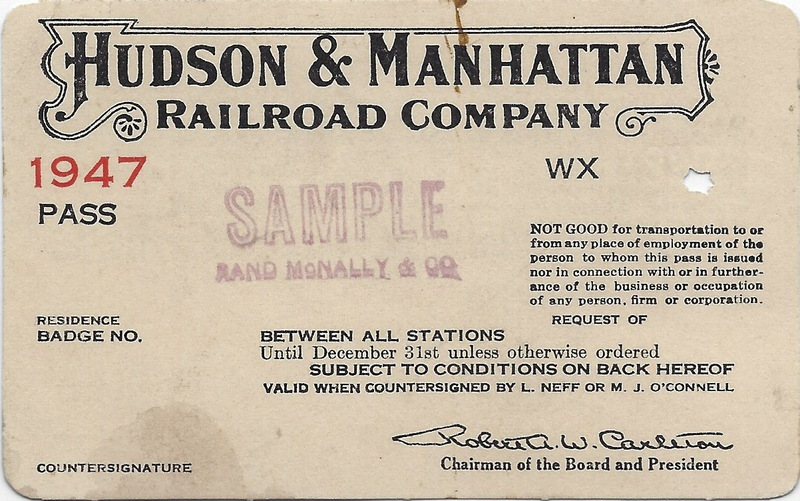 |
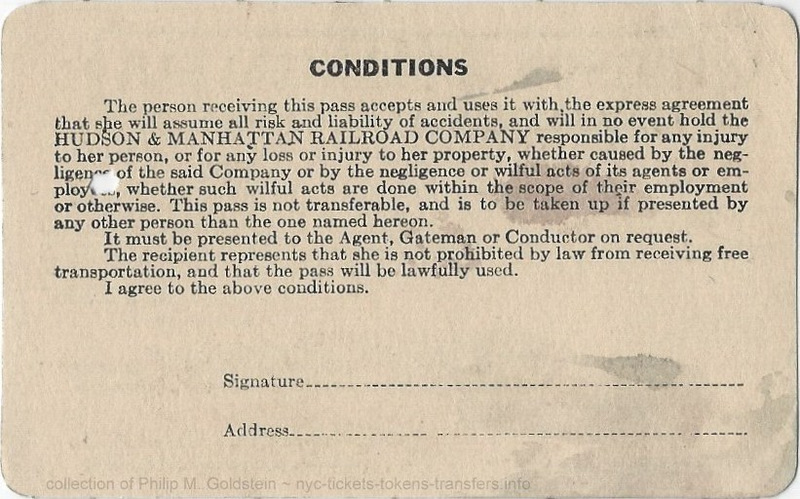 |
| 1947 - WX Robert A. W. Carleton, Chairman of the board and President Rand McNally & Company sample |
|
At some point within 2010 - 2020, a great deal of samples printed by the Rand McNally Company; including passes, tickets and other fiscal items & forms for many transit companies (especially for the New York area) have surfaced on the retail market. It is unknown whether the samples are actually a form / ticket / pass ordered by and used by the Hudson & Manhattan Railroad and kept as a record of production by the Rand McNally Company (the most likely explanation as other companies are observed) or were samples were for prospective designs as proposed by Rand McNally. We have yet to see an issued example in counterpart to a known sample. Most appear to have been affixed into an album and exhibit some form of damage. |
|
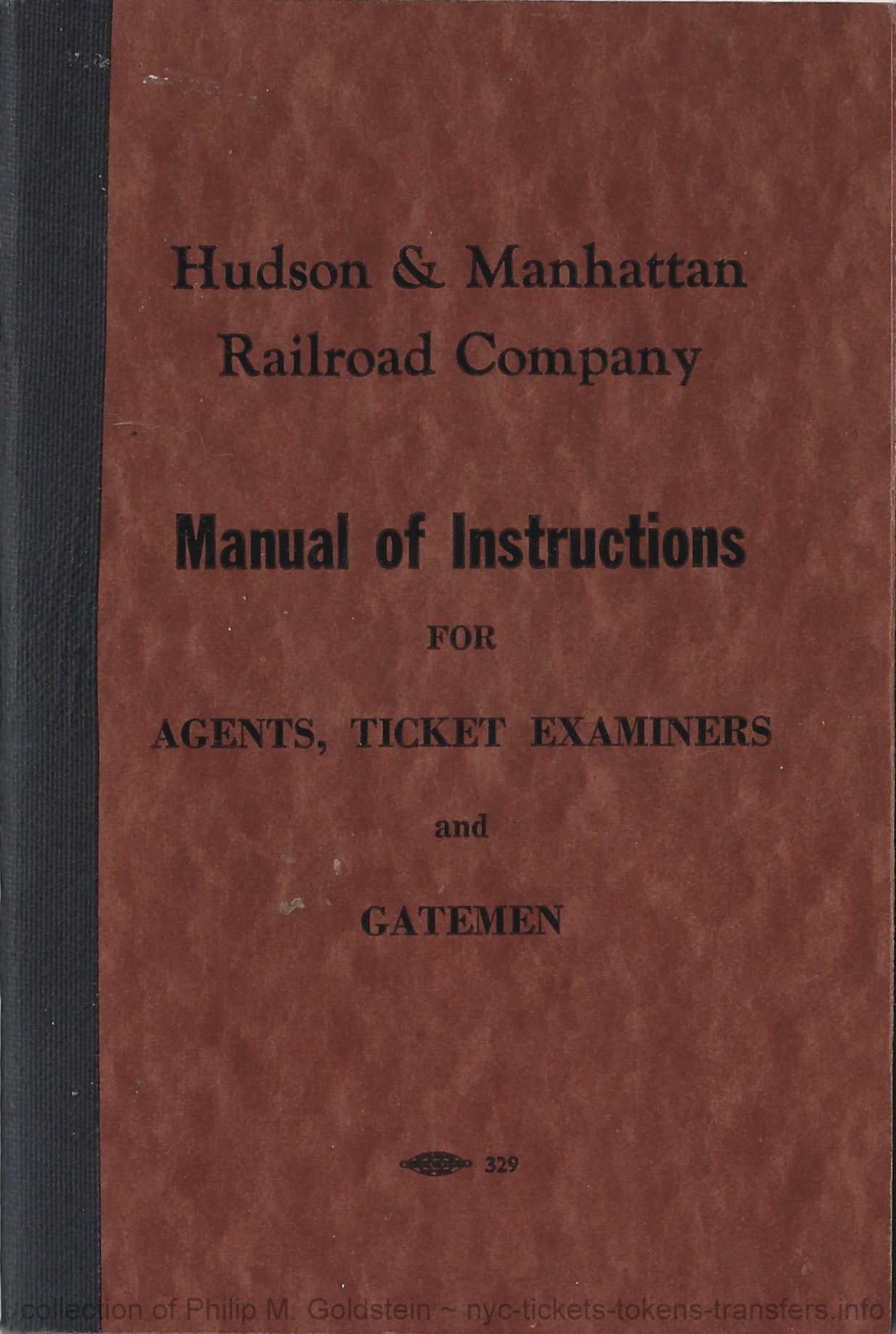 |
|
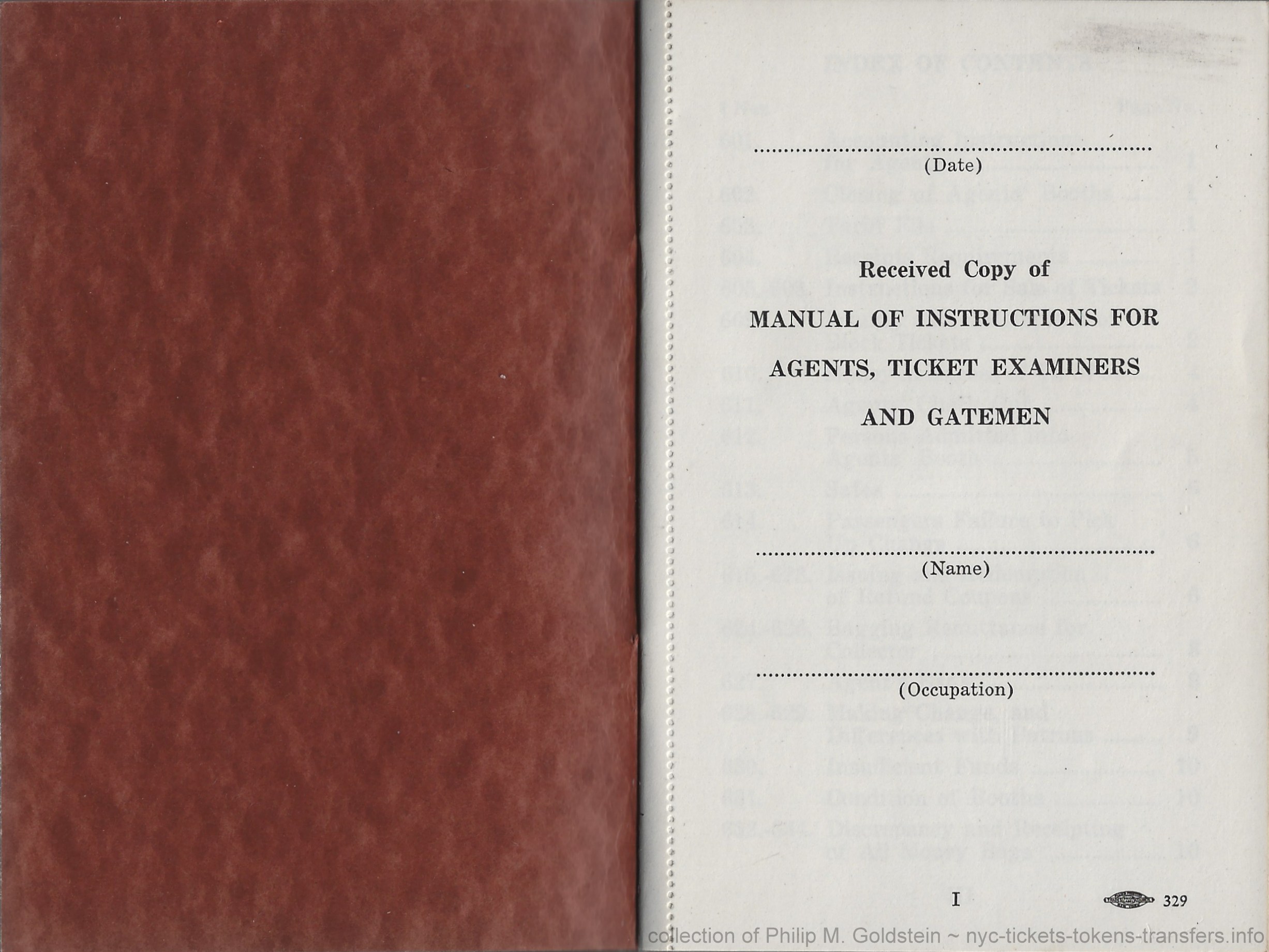 |
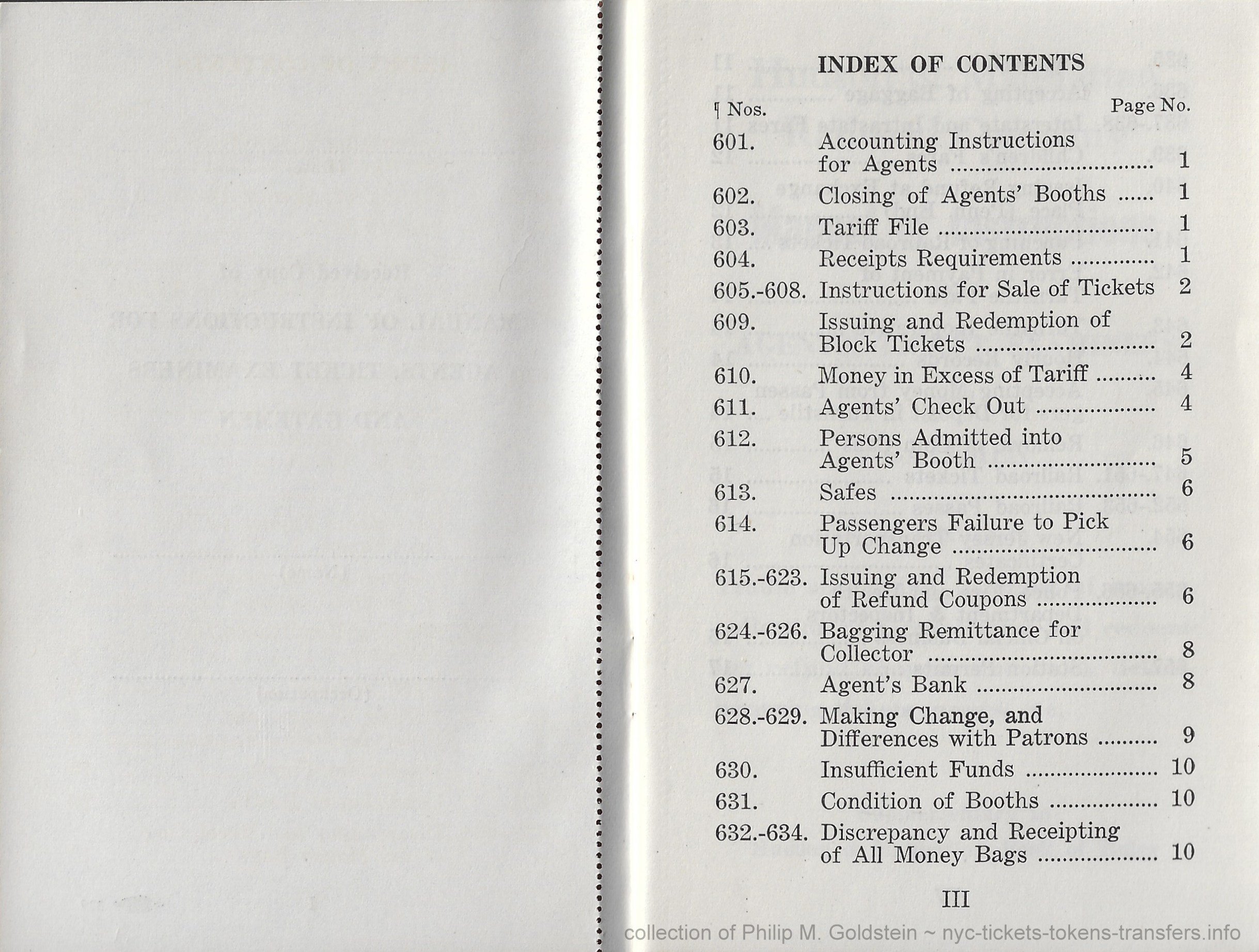 |
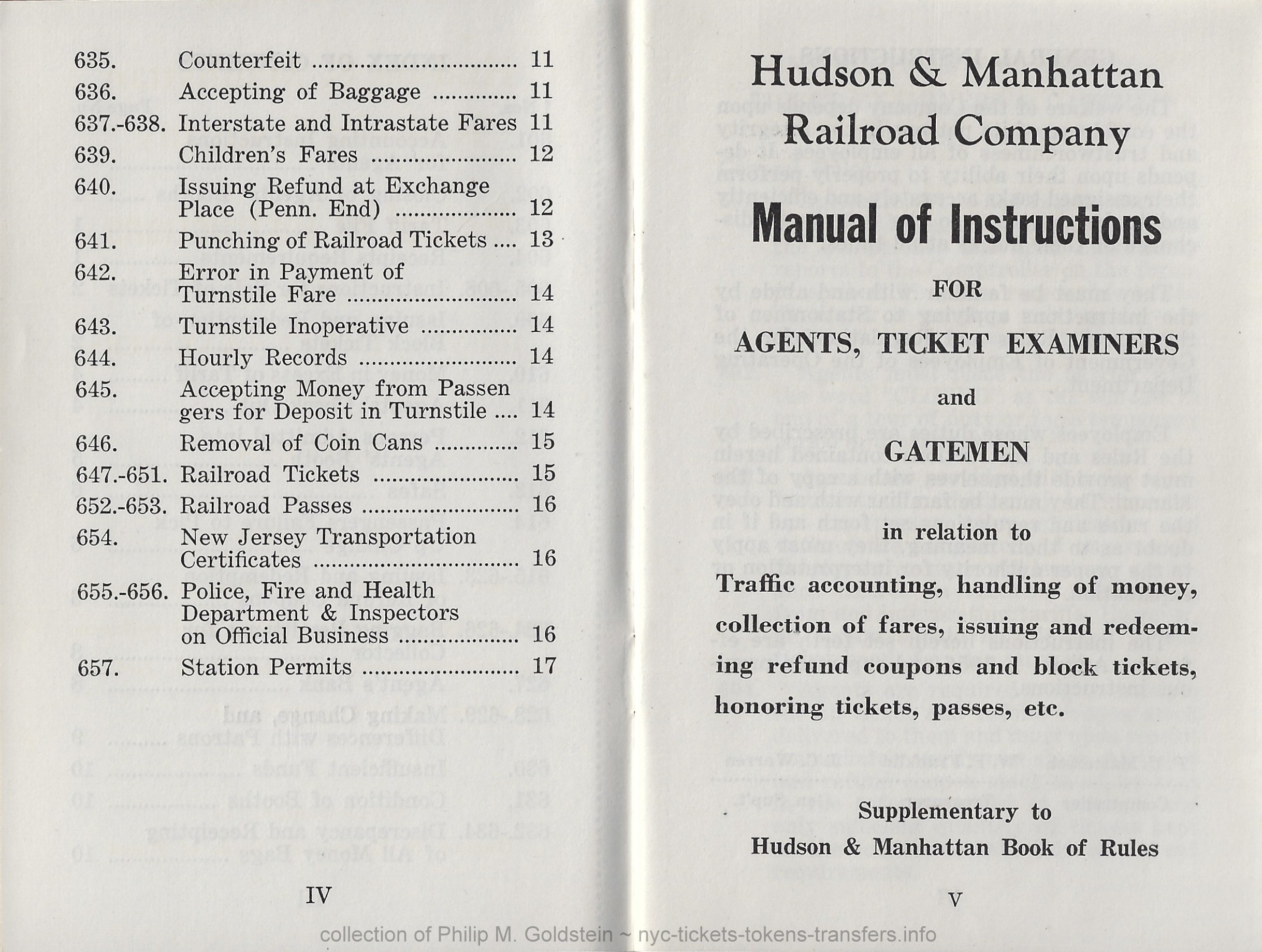 |
 |
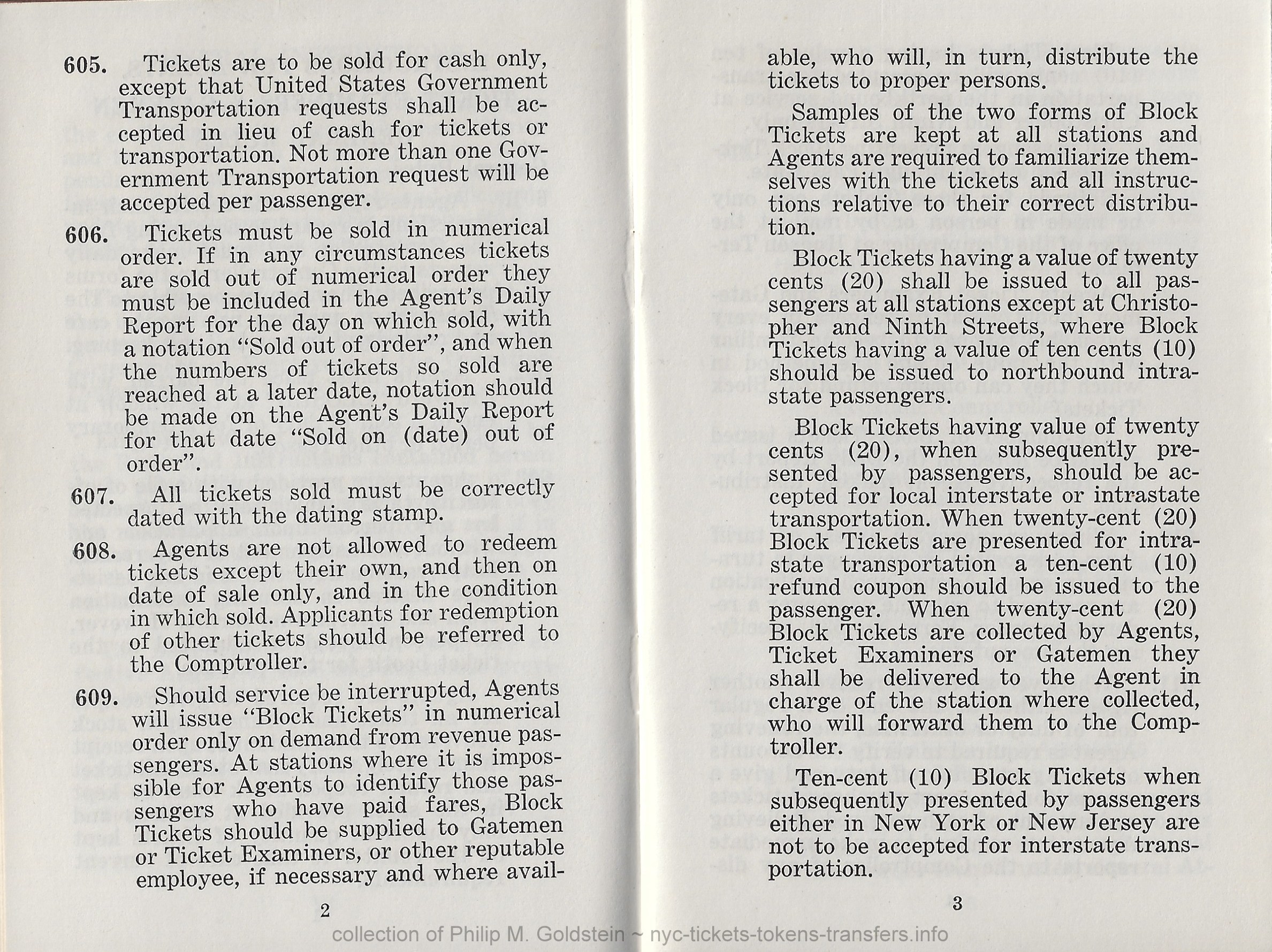 |
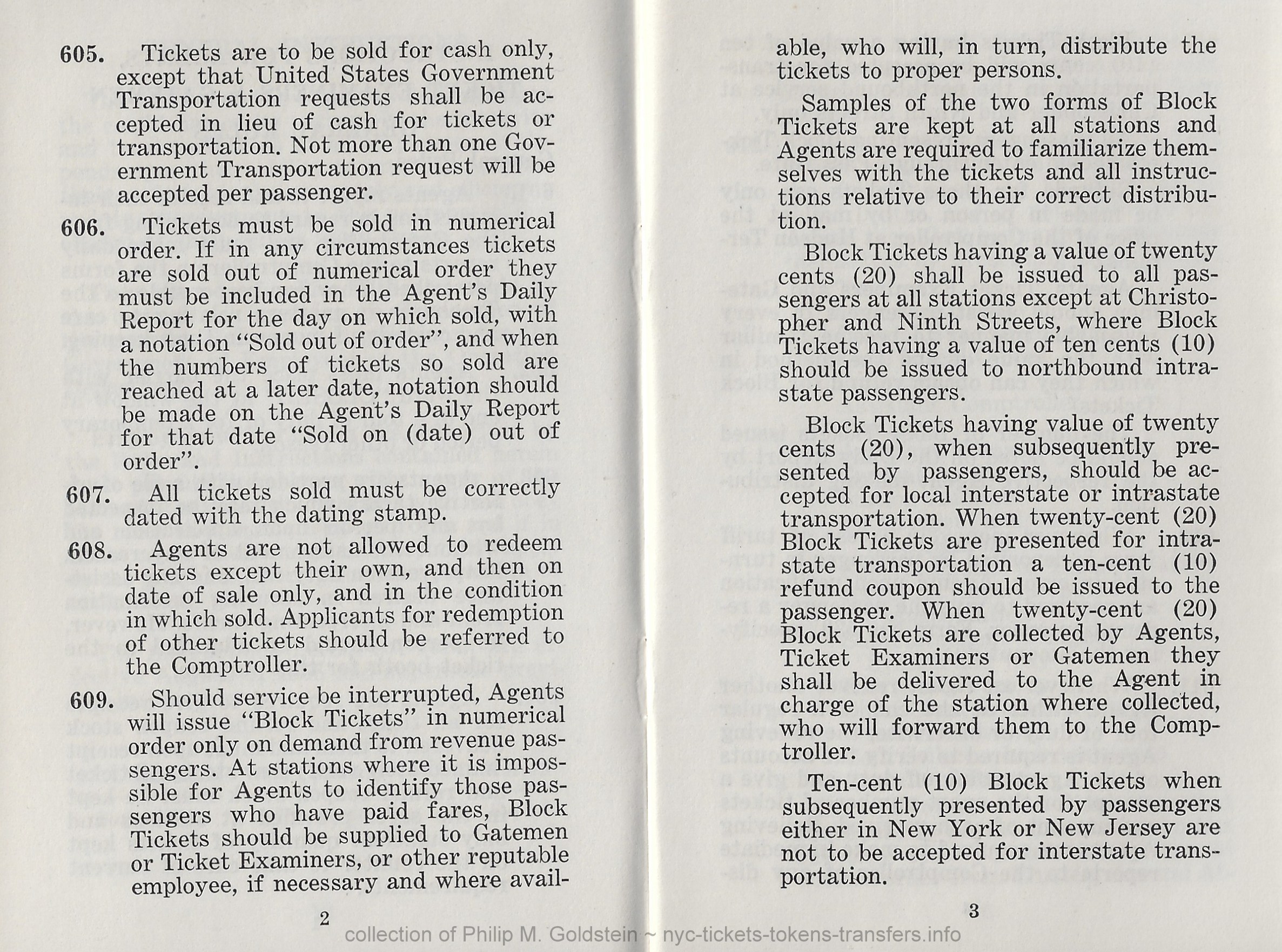 |
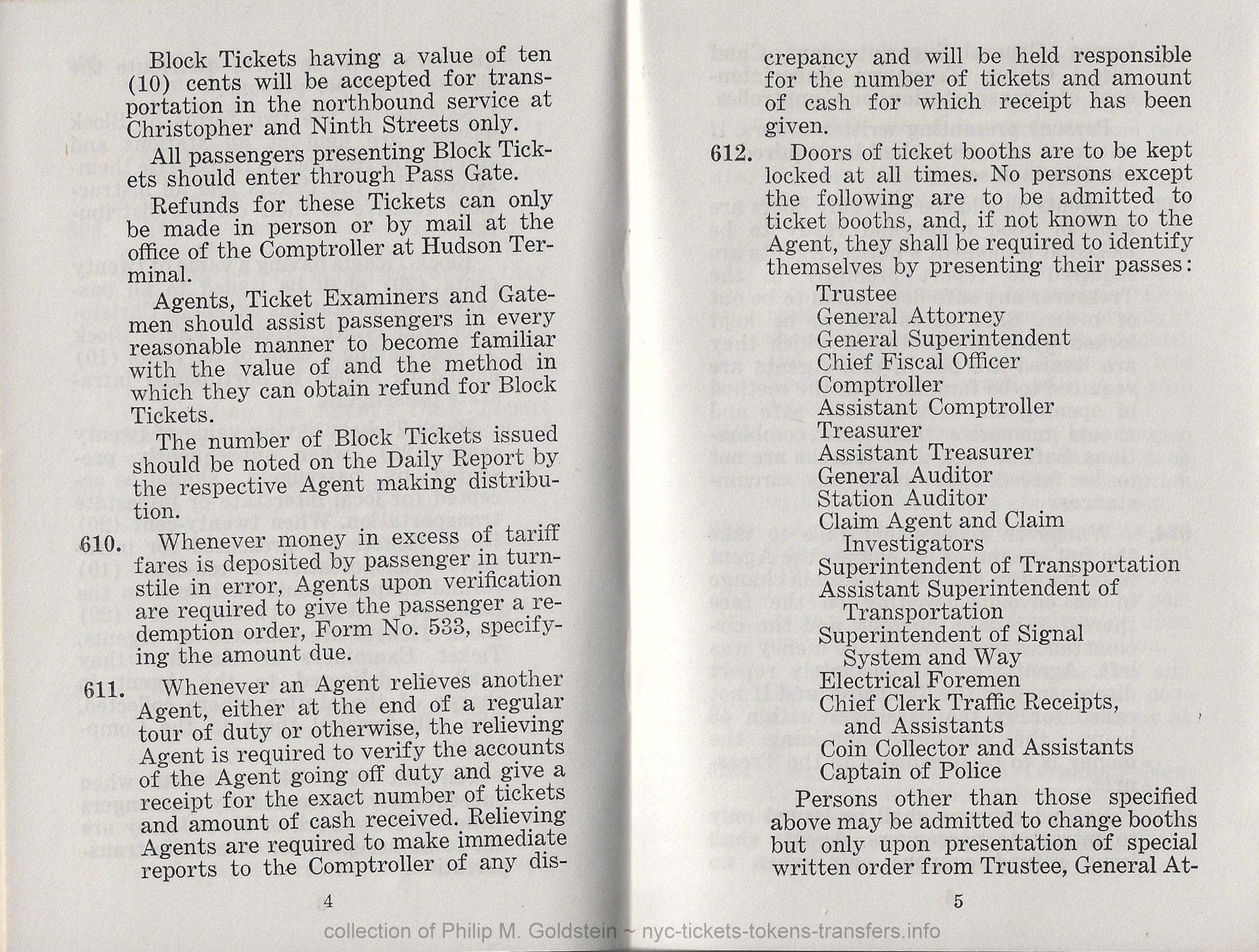 |
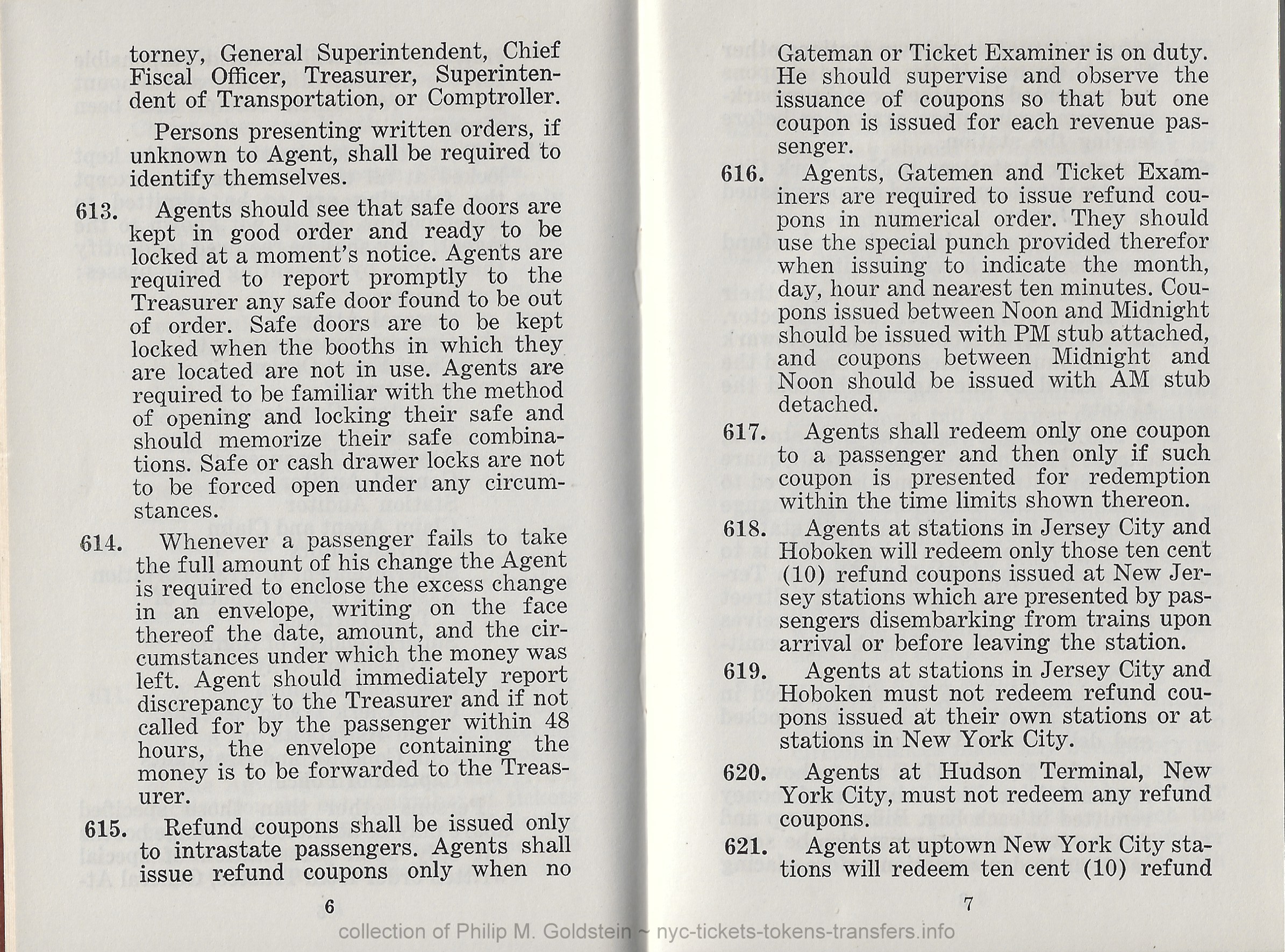 |
 |
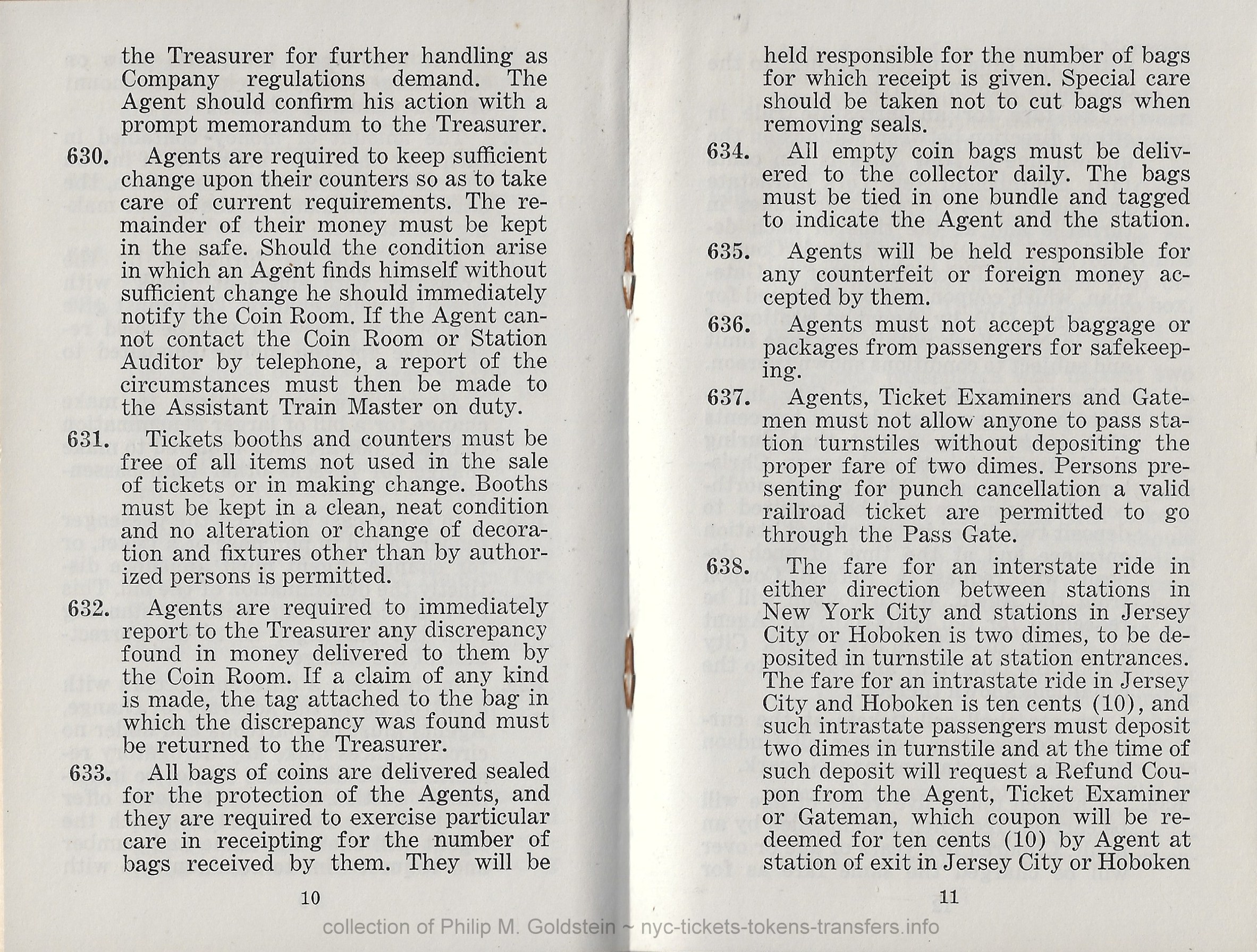 |
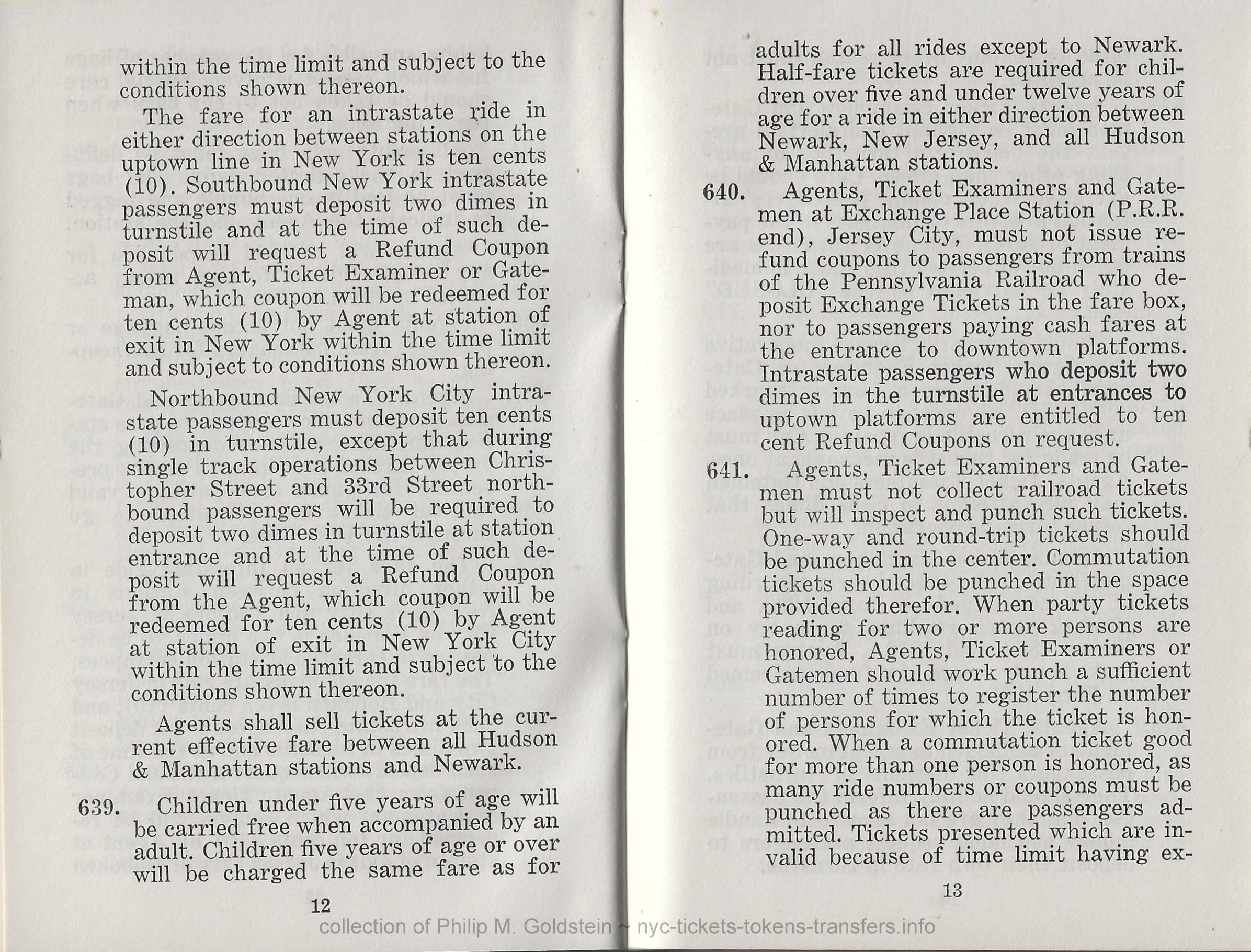 |
 |
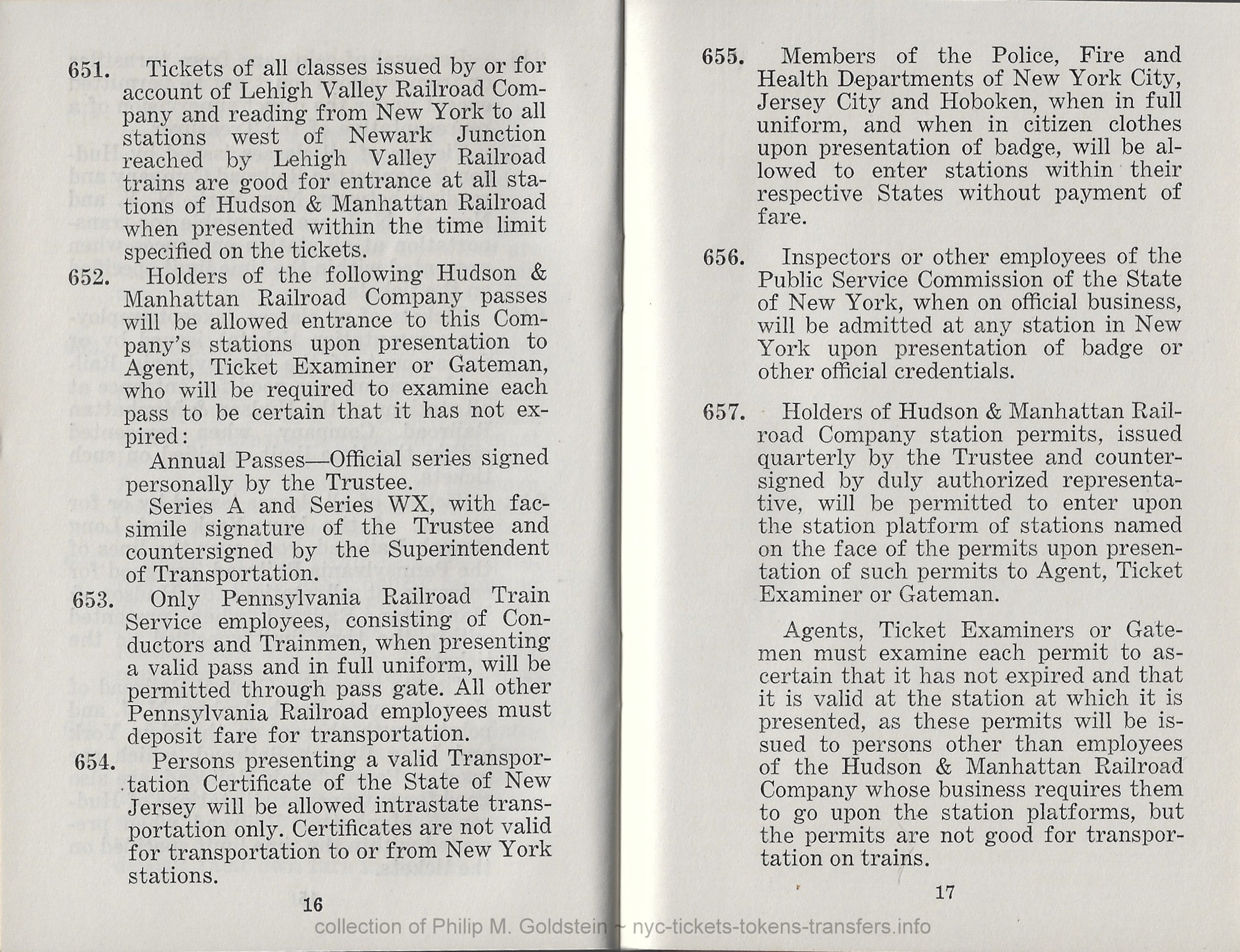 |
intentionally left blank |


| This next issue is simply a 10 trip ticket, with primitive magnetic data stripe encoding, in both unused (left) and used (right). These tickets were used in an automated turnstile, where each successive use would chop off the next trip remaining on the left edge of the face, as well as imprint the ticket with a printed code. Upon the tenth trip, the ticket was invalidated.Unfortunately, the meaning or deciphering of printed code is currently unknown.. | ||||
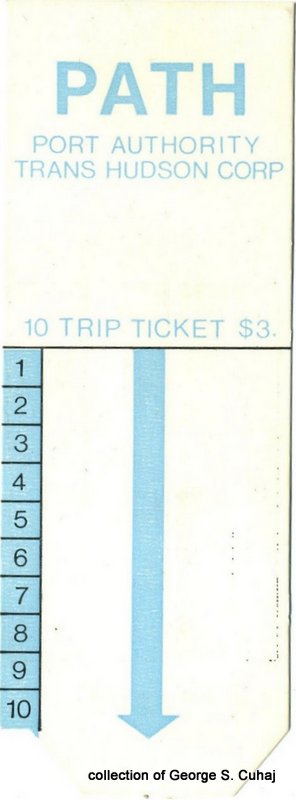 |
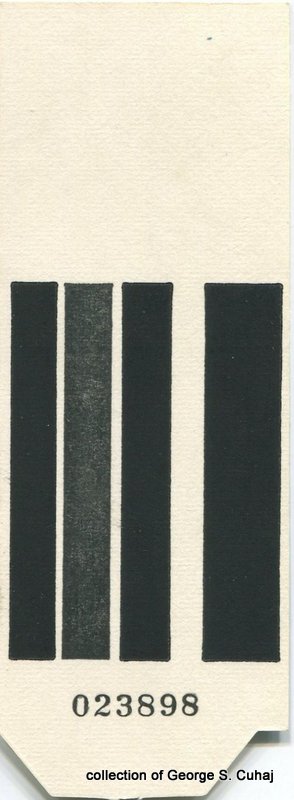 |
..... | 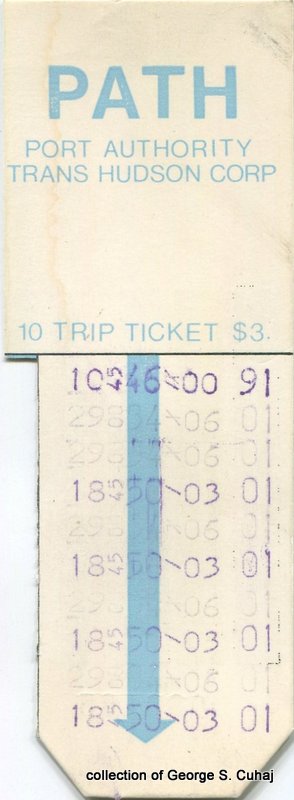 |
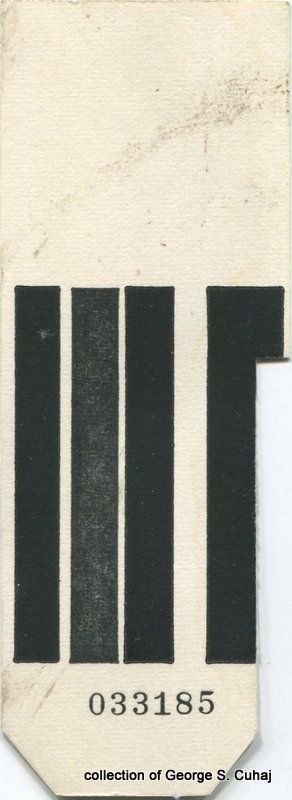 |
| 4 15/16" x 1 13/16" | ||||
 |
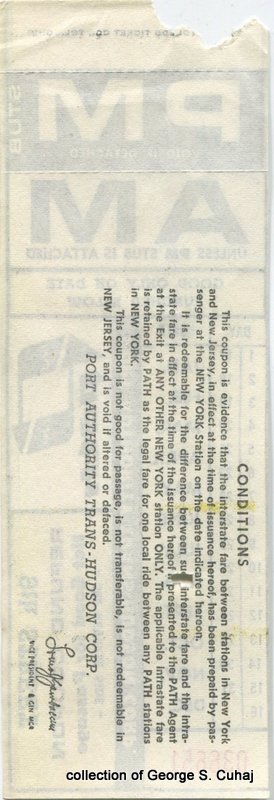 |
|||
| 4 15/16" x 1 13/16" | ||||
 |
||
 |
||
 |